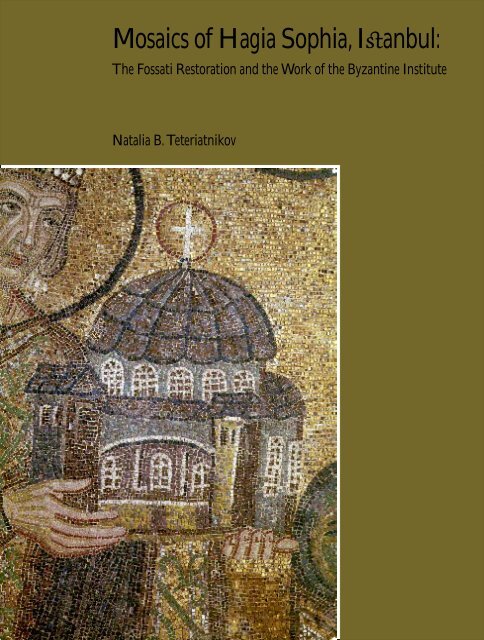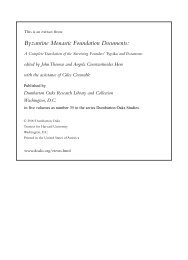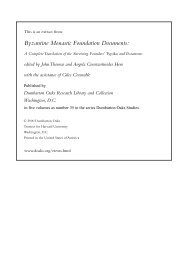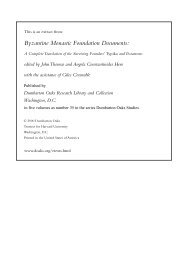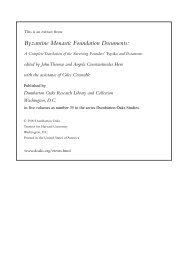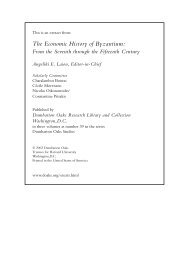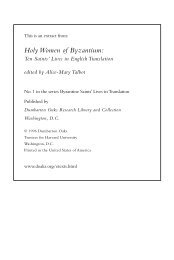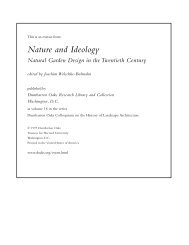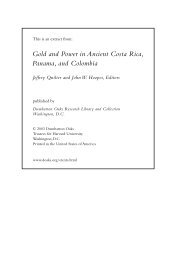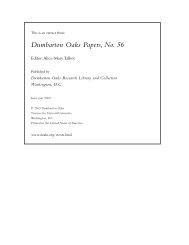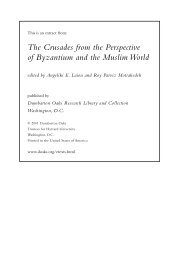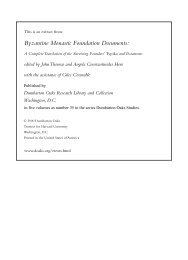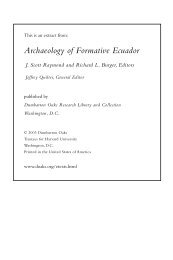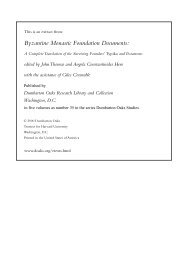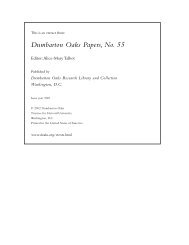Download: Mosaics of Hagia Sophia, Istanbul - Dumbarton Oaks
Download: Mosaics of Hagia Sophia, Istanbul - Dumbarton Oaks
Download: Mosaics of Hagia Sophia, Istanbul - Dumbarton Oaks
Create successful ePaper yourself
Turn your PDF publications into a flip-book with our unique Google optimized e-Paper software.
<strong>Mosaics</strong> <strong>of</strong> <strong>Hagia</strong> <strong>Sophia</strong>, <strong>Istanbul</strong>:<br />
The Fossati Restoration and the Work <strong>of</strong> the Byzantine Institute<br />
Natalia B. Teteriatnikov
<strong>Mosaics</strong> <strong>of</strong> <strong>Hagia</strong> <strong>Sophia</strong>, <strong>Istanbul</strong>:<br />
The Fossati Restoration and the Work <strong>of</strong> the Byzantine Institute<br />
Natalia B. Teteriatnikov<br />
<strong>Dumbarton</strong> <strong>Oaks</strong> Research Library and Collection<br />
Washington, D.C.
© 1998 <strong>Dumbarton</strong> <strong>Oaks</strong><br />
Trustees for Harvard University<br />
Washington, D.C.<br />
Cover illustration<br />
Detail, lunette mosaic in the south<br />
vestibule <strong>of</strong> <strong>Hagia</strong> <strong>Sophia</strong>, 10th century.<br />
The emperor Justinian holding a<br />
representation <strong>of</strong> <strong>Hagia</strong> <strong>Sophia</strong><br />
(photo: Byzantine Institute, ca. 1940)<br />
ISBN 0–88402–264–1
Contents<br />
Acknowledgments v<br />
Introduction 1<br />
The Fossati Restoration 3<br />
The Byzantine Institute: Revealing the Past 26<br />
Background 26<br />
Conservation 29<br />
Cleaning the <strong>Mosaics</strong> 39<br />
Mosaic Techniques 44<br />
Preservation through Imaging 59<br />
Conclusion 63<br />
Plates 64
Acknowledgments<br />
The catalogue and exhibition <strong>Mosaics</strong> <strong>of</strong> <strong>Hagia</strong> <strong>Sophia</strong>, <strong>Istanbul</strong> owe much to<br />
the involvement and assistance <strong>of</strong> numerous institutions and individuals. For her<br />
support and encouragement I would like to thank Angeliki Laiou, director <strong>of</strong><br />
<strong>Dumbarton</strong> <strong>Oaks</strong>. I also express my pr<strong>of</strong>ound gratitude to Alice-Mary Talbot,<br />
director <strong>of</strong> Byzantine Studies at <strong>Dumbarton</strong> <strong>Oaks</strong>, whose helpful suggestions,<br />
insightful criticism, and editorial expertise brought both the catalogue and the<br />
exhibit to fruition. My special thanks go to Pr<strong>of</strong>essor William L. MacDonald for<br />
sharing with me his wealth <strong>of</strong> knowledge about the Byzantine Institute. I would<br />
also like to thank Susan Boyd, curator <strong>of</strong> the Byzantine collection at <strong>Dumbarton</strong><br />
<strong>Oaks</strong>, and Ioli Kalavrezou, pr<strong>of</strong>essor <strong>of</strong> fine arts at Harvard University, for their<br />
helpful suggestions regarding the catalogue.<br />
Other staff members <strong>of</strong> <strong>Dumbarton</strong> <strong>Oaks</strong> were also invaluable in this<br />
endeavor. I am grateful for their help, especially that <strong>of</strong> Michelle Savant and Larry<br />
Shutts, assistants in the Byzantine Photograph and Fieldwork Archives; cabinetmaker<br />
Astor Moore and Suzanne Mercury, his assistant; and photographer Joe<br />
Mills. My gratitude is also expressed to the Byzantine Library, especially to Irene<br />
Vaslef, head librarian, and Mark Zapatka, assistant to the librarian, and the publications<br />
staff <strong>of</strong> Glenn Ruby, publishing manager, Robin Surratt, senior editor, and<br />
Matthew Rieck, production assistant.<br />
I also would like to express my gratitude to Amy Brauer, associate curator<br />
<strong>of</strong> ancient art at the Fogg Art Museum; Helen Evans, associate curator <strong>of</strong> the<br />
Medieval Department at the Metropolitan Museum <strong>of</strong> Art; Thomas Mathews,<br />
pr<strong>of</strong>essor <strong>of</strong> the history <strong>of</strong> art at the Institute <strong>of</strong> Fine Arts, New York University;<br />
Irina Andreescu Treadgold, pr<strong>of</strong>essor <strong>of</strong> visual and performing arts at Saint Louis<br />
University; Ali Kilickaya, director <strong>of</strong> the <strong>Hagia</strong> <strong>Sophia</strong> Museum; Nazan Karakas<br />
and Neslihan Yalav, librarians at the <strong>Istanbul</strong> Library; Orhan M. Golak <strong>of</strong> the<br />
Research Center for Islamic History and Culture <strong>of</strong> <strong>Istanbul</strong>; Mehmet Ihsan<br />
Tunay, associate pr<strong>of</strong>essor at <strong>Istanbul</strong> University; and Hayri Yilmaz <strong>of</strong> <strong>Istanbul</strong><br />
University.<br />
Thanks to the fine conservation work <strong>of</strong> Arthur Page and Mark Knight, we<br />
are able to present in the exhibition three <strong>of</strong> the reproductions <strong>of</strong> the mosaic panels<br />
made by the Byzantine Institute staff. Most <strong>of</strong> the photographs for the catalogue<br />
and exhibition were printed by Joe Mills from Byzantine Institute negatives.<br />
5
6<br />
Introduction<br />
<strong>Hagia</strong> <strong>Sophia</strong>, <strong>of</strong>ten called the Great Church, was<br />
built and decorated from A.D. 532 to 537, during the reign<br />
<strong>of</strong> the emperor Justinian (Fig. 1). Over the years, figural<br />
mosaics were added to the original non-figural mosaic<br />
program, reflecting the ongoing political, religious, and<br />
ceremonial needs <strong>of</strong> the cathedral’s patrons and <strong>of</strong> the<br />
building itself. Wealthy patrons, motivated by religious<br />
fervor, chose mosaics for church decoration because <strong>of</strong><br />
their jewel-like quality and sparkling radiance. After the fall<br />
<strong>of</strong> Constantinople in 1453, the church was converted into a<br />
mosque (Aya S<strong>of</strong>ya Camii), and the mosaics were covered<br />
with whitewash and plaster. They remained hidden for 400<br />
years, until the architects Gaspare and Giuseppe Fossati<br />
temporarily uncovered them in 1848 and 1849. In 1931<br />
<strong>Hagia</strong> <strong>Sophia</strong> was deconsecrated as a mosque and opened<br />
as a museum with the permission <strong>of</strong> the president <strong>of</strong> the<br />
Republic <strong>of</strong> Turkey, Kemal Atatürk. Between 1931 and<br />
1949, the mosaics were uncovered and cleaned by the staff<br />
<strong>of</strong> the Byzantine Institute. The restoration by the Fossatis<br />
in the nineteenth century and the consolidation and<br />
cleaning by the Byzantine Institute in the twentieth century<br />
have been invaluable to the preservation <strong>of</strong> the mosaics<br />
and to the dissemination <strong>of</strong> information about them.<br />
The photographs and color transparencies produced<br />
during the institute’s conservation effort are now key<br />
to the study <strong>of</strong> Byzantine history and art. Most <strong>of</strong> the<br />
Byzantine Institute’s archival materials were transferred to<br />
<strong>Dumbarton</strong> <strong>Oaks</strong> in 1953, soon after institute director<br />
Thomas Whittemore’s death (Fig. 2). 1 Numerous plans,<br />
The Byzantine Institute negatives and Sebah and Joaillier photographs<br />
used in the production <strong>of</strong> this catalogue are now housed in the<br />
<strong>Dumbarton</strong> <strong>Oaks</strong> Byzantine Photograph and Fieldwork Archives.<br />
1 The archival materials were catalogued by Jeff Schlossberg in 1981.<br />
1<br />
Coin <strong>of</strong> Justinian, the<br />
earliest dated coin from<br />
Constantinople, struck in<br />
538/9, just after <strong>Hagia</strong><br />
<strong>Sophia</strong> was built<br />
This coin reflects<br />
Justinian’s devotion to<br />
the cross. He is shown<br />
holding a globe with a<br />
cross in his right hand,<br />
and another cross<br />
appears to his left hand.<br />
(Byzantine collection,<br />
<strong>Dumbarton</strong> <strong>Oaks</strong>)
Thomas Whittemore<br />
(photo: Maurice Seymour, 1953[?],<br />
courtesy <strong>of</strong> W. L. MacDonald)<br />
drawings, and painted copies <strong>of</strong> the mosaics and research materials from the<br />
conservation campaign are now housed in the Byzantine Photograph and Fieldwork<br />
Archives and are among <strong>Dumbarton</strong> <strong>Oaks</strong>’ most significant holdings. This<br />
catalogue and exhibit—held in conjunction with the symposium “Constantinople:<br />
The Fabric <strong>of</strong> the City,” 1-3 May 1998—are based on information retrieved from<br />
the Byzantine Institute’s records. These materials, which have never been thoroughly<br />
studied, contain important information not only on the conservation <strong>of</strong> the<br />
mosaics, but also on their history, iconography, style, and technique. Examination<br />
<strong>of</strong> the drawings, tracings, copies, and photographs produced by the Byzantine<br />
Institute from “close quarters”—the term used by Whittemore—lets the modern<br />
viewer truly appreciate the quality <strong>of</strong> these mosaics. 2 They also reveal to the viewer<br />
the changes made in the mosaics from the Justinianic era through the centuries.<br />
2 It was as a result <strong>of</strong> Whittemore’s publication <strong>of</strong> the majority <strong>of</strong> the mosaics between 1933 and<br />
1952 that they became widely known among scholars as well as the general public. Some <strong>of</strong> the<br />
mosaics were also published by C. Mango, E. J. W. Hawkins, P. Underwood, and R. Cormack.<br />
For these and related references, see below, note 40.<br />
2<br />
7
8<br />
The Fossati Restoration<br />
The work <strong>of</strong> the Byzantine Institute has greatly enhanced our understanding<br />
<strong>of</strong> the nineteenth-century restoration <strong>of</strong> <strong>Hagia</strong> <strong>Sophia</strong>’s mosaics by Gaspare<br />
and Giuseppe Fossati. The institute’s conservators approached the restoration with<br />
interest and respect for its historical significance, and they made detailed studies<br />
and photographic records <strong>of</strong> it.<br />
The Fossatis, architects and brothers, were natives <strong>of</strong> the Italian-speaking<br />
region <strong>of</strong> Switzerland who were commissioned in May 1847 by Sultan Abdul<br />
Medjid to clean and restore the Aya S<strong>of</strong>ya mosque, renovating its exterior and<br />
interior; the work was completed two years later, in 1849. 3 The building was in<br />
shabby condition and was dangerous, so the brothers’ primary task was to preserve<br />
the structure through the consolidation <strong>of</strong> cracks in the walls, dome, columns,<br />
marble revetments, and stucco decoration. Their work was indeed useful, but they<br />
could not correct a number <strong>of</strong> major problems, because they had not yet been<br />
diagnosed.<br />
The Byzantine figural mosaics were discovered by accident during work on<br />
the revetments and plaster in 1848. A newly uncovered mosaic in the north aisle<br />
vault was shown to the sultan, and he was so impressed by the golden cubes he saw<br />
that he ordered the mosaics cleared <strong>of</strong> plaster. The Fossatis understood the historical<br />
significance <strong>of</strong> the mosaics and prepared drawings and watercolors <strong>of</strong> them (Fig.<br />
3). Hoping for Russian patronage, the Fossatis presented their work to Tzar<br />
Nicholas I. 4 Although the tzar expressed interest in the drawings, the discussion <strong>of</strong><br />
a subvention for publication was postponed for an indefinite length <strong>of</strong> time. Ulti-<br />
3 On the Fossatis, see E. Motta, “I Fossati: Una famiglia d’artisti,” in Bolletino storico della Svizzera<br />
italiano (Bellinzona, 1883), 221-25, 248, 283; U. Thieme and F. Becker, Allgemeines Lexikon der<br />
besten Künstler (Leipzig, 1916), XII: 239; T. Lacchia, I Fossati: architetti del sultano di Turchia (Rome,<br />
1943); C. Mango, Materials for the Study <strong>of</strong> the <strong>Mosaics</strong> <strong>of</strong> St. <strong>Sophia</strong> at <strong>Istanbul</strong>, <strong>Dumbarton</strong> <strong>Oaks</strong><br />
Studies 8 (Washington, D.C., 1962), 5-21, with further bibliography; U. Peschlow, Gaspare<br />
Fossati, Die <strong>Hagia</strong> <strong>Sophia</strong>: Nach dem Tafelwerk von 1852 (Dortmund, 1980); S. Palumbo-Fossati,<br />
Notizie su artisti, uomini di cultura ed artigiani di Morcote di Vico Morcote (Basel, 1984); G. Costas et<br />
al., 1809-1883, Gaspare Fossati: architetto pittore, pittore architetto (Lugano, 1992), 123-24, with<br />
further bibliography.<br />
4 Mango, <strong>Mosaics</strong>, 19; also see the Fossati archives housed at the Bellinzona Archives, box 21, nos.<br />
1411-12.
mately, the Fossatis’ studies would not be published until more than a century<br />
later. 5 Out <strong>of</strong> respect for Muslim religious customs prohibiting the representation<br />
<strong>of</strong> humans, the figural mosaic panels were re-covered with plaster and painted (Fig.<br />
4). The Fossatis left the ornamental Justinianic mosaics exposed and painted areas<br />
<strong>of</strong> missing tesserae with images matching the surviving patterns. After completing<br />
the project, Gaspare Fossati published an album <strong>of</strong> lithographs made from his<br />
watercolors, including the exterior and interior <strong>of</strong> <strong>Hagia</strong> <strong>Sophia</strong>, and dedicated it<br />
to Sultan Abdul Medjid in 1852 (Figs. 5-7). 6<br />
Thomas Whittemore claimed that <strong>Hagia</strong> <strong>Sophia</strong>’s mosaics have survived<br />
largely due to the work <strong>of</strong> the Fossatis. 7 The extent <strong>of</strong> their consolidation and<br />
5 See Mango, <strong>Mosaics</strong>, figs. 6, 9, 10-13, 15-16, 20-35, 42-46, 48-51, 52, 55, 57, 61, 63, 69, 71, 73-78,<br />
80-89, 92-102, 104-5, 113-17.<br />
6 G. Fossati, Aya S<strong>of</strong>ia, Constantinople, as Recently Restored by Order <strong>of</strong> H. M. the Sultan Abdul-Medjid.<br />
From the Original Drawings by Chevalier Gaspard Fossati, lithographed by Louis Haghe (London,<br />
1852).<br />
7 T. Whittemore, The <strong>Mosaics</strong> <strong>of</strong> St. <strong>Sophia</strong> at <strong>Istanbul</strong>. Preliminary Report on the First Year’s Work,<br />
1931-1932: The <strong>Mosaics</strong> <strong>of</strong> the Narthex (Oxford, 1933), 9, hereafter Whittemore, First Preliminary<br />
Report.<br />
3<br />
Fossati drawing <strong>of</strong> the emperor John V<br />
Palaeologus in the eastern arch, north side<br />
The mosaic <strong>of</strong> this emperor, who ruled<br />
from 1341 to 1391, has only recently<br />
been uncovered. It dates to ca. 1354.<br />
(after Mango, <strong>Mosaics</strong>, fig. 97)<br />
9
estoration is evident in vast areas <strong>of</strong> the vaults and walls in<br />
the narthex (Figs. 8-10), naos, dome, and galleries (Figs. 11-<br />
14; also see Figs. 22, 23). The Fossatis had strengthened the<br />
mosaics with iron cramps before recovering them with plaster.<br />
During the course <strong>of</strong> the work <strong>of</strong> the Byzantine Institute, the<br />
conservators removed sections <strong>of</strong> the Fossati plaster repairs<br />
and paint covering the original mosaics. In many cases, for<br />
instance in that <strong>of</strong> the Deesis panel (see Fig. 58), original<br />
mosaics were not found under some sections <strong>of</strong> the nineteenth-century<br />
repairs, so the Fossati plaster and paint were<br />
left in situ. In those instances in which it was not possible to<br />
preserve deteriorating Fossati plaster and paint, the areas were<br />
photographed before the material was removed.<br />
The conservators <strong>of</strong> the Byzantine Institute who<br />
consolidated and cleaned the original mosaics were critical <strong>of</strong><br />
some <strong>of</strong> the Fossati methods <strong>of</strong> conservation. An examination<br />
<strong>of</strong> Fossati plaster samples shows that it consists only <strong>of</strong> two<br />
layers, instead <strong>of</strong> three layers as found in the bedding <strong>of</strong> the<br />
10<br />
4<br />
Inner narthex, mosaic panel in<br />
the lunette above the royal doors<br />
The Fossatis painted this<br />
Justinianic eight-point star<br />
over a whitewashed mosaic<br />
panel depicting an emperor<br />
kneeling before Christ<br />
enthroned. See Figures 64<br />
and 65. (photo: P. Iskender,<br />
Byzantine Institute, 1932)
7<br />
5<br />
6<br />
(above) General view <strong>of</strong><br />
<strong>Hagia</strong> <strong>Sophia</strong> from the<br />
southwest before the Fossati<br />
brothers undertook their<br />
restoration <strong>of</strong> the building<br />
(after Fossati, Aya S<strong>of</strong>ia,<br />
pl. 25)<br />
(right) Central nave after<br />
the Fossati restoration<br />
(after Fossati, Aya S<strong>of</strong>ia,<br />
pl. 3)<br />
(left) South vestibule after the Fossati restoration<br />
Ornamental patterns, including Gothic-style<br />
rosettes, were used to cover the 10th-century<br />
lunette mosaic above the doorway <strong>of</strong> Justinian<br />
and Constantine before the Virgin enthroned<br />
and Christ child. (after Fossati, Aya S<strong>of</strong>ia, 11 pl. 1)
8<br />
Inner narthex, looking<br />
toward the north, late<br />
19th century<br />
<strong>Mosaics</strong> cover the<br />
vaults and transverse<br />
arches <strong>of</strong> the ceiling as<br />
well as the lunettes<br />
(photo: Sebah and<br />
Joaillier)
9<br />
10<br />
(right) Inner narthex, looking toward the window s<strong>of</strong>fit<br />
The center <strong>of</strong> this vault is decorated with a<br />
rosette in a medallion flanked by Latin crosses.<br />
(photo: Byzantine Institute)<br />
(left) Vault <strong>of</strong> the central bay<br />
<strong>of</strong> the inner narthex<br />
All the bay vaults <strong>of</strong> the<br />
narthex have the same<br />
mosaic scheme. The groin<br />
vaults <strong>of</strong> each bay are<br />
outlined with ornamental<br />
bands <strong>of</strong> a jeweled<br />
christogram in a central<br />
medallion. The center <strong>of</strong><br />
each vault segment is<br />
decorated with an eightpointed<br />
star with stylized<br />
pine cones and floating<br />
floral motifs at the ends.<br />
(photo: Byzantine Institute)
11<br />
Fossati drawing <strong>of</strong> mosaics on the south wall <strong>of</strong> the west gallery<br />
Below the cross in the medallion is an ornamental band<br />
consisting <strong>of</strong> diamonds and crosses on a diagonal, similar<br />
to the patterns found in the dome ribs and window sills.<br />
(after Mango, <strong>Mosaics</strong>, 42)<br />
12<br />
Dome<br />
The forty ribs <strong>of</strong> the dome radiate<br />
from a central medallion that<br />
originally was decorated with an<br />
image <strong>of</strong> the cross. The sixthcentury<br />
court poet Paul Silentiarius<br />
said <strong>of</strong> it, “At the very navel the sign<br />
<strong>of</strong> the cross is depicted within a<br />
circle by means <strong>of</strong> minute mosaic so<br />
that the Saviour <strong>of</strong> the whole world<br />
may for ever protect the church;<br />
while at the base <strong>of</strong> the half-sphere<br />
are fashioned forty arched windows<br />
through which the rays <strong>of</strong> fairhaired<br />
Dawn are channelled”<br />
(Descriptio S. <strong>Sophia</strong>e 506, tr. C.<br />
Mango, Art <strong>of</strong> the Byzantine Empire,<br />
312-1453 [Toronto, 1986], 83.<br />
(photo: Byzantine Institute)
13<br />
Detail, the dome<br />
Each rib <strong>of</strong> the dome is<br />
decorated with an alternating<br />
pattern <strong>of</strong> diamonds and<br />
crosses on a diagonal.<br />
(photo: Byzantine Institute)
14<br />
An apse window<br />
The s<strong>of</strong>fit <strong>of</strong> each window<br />
in the apse is outlined with<br />
a narrow ornamental band<br />
consisting <strong>of</strong> the diamondand-cross<br />
pattern on a<br />
diagonal.<br />
(photo: Byzantine Institute)<br />
original mosaics. 8 Although the Fossatis understood the<br />
importance <strong>of</strong> preserving the original mosaics, their<br />
hurried pace <strong>of</strong> work and the level <strong>of</strong> technical knowledge<br />
at the time precluded their doing a thorough job.<br />
Most but not all <strong>of</strong> the mosaics were preserved.<br />
Throughout the restoration, deteriorated areas <strong>of</strong><br />
mosaic were simply cut away and filled with new plaster<br />
and painted over. 9 With some variation, the removal <strong>of</strong><br />
the original mosaic was the same method <strong>of</strong> restoration<br />
used on medieval mosaics in nineteenth-century Italy.<br />
Numerous mosaics in the cathedral <strong>of</strong> San Marco in<br />
Venice, the Cappella Palatina in Palermo, and the<br />
cathedral in Torcello were cut away, but they were then<br />
replaced with new tesserae rather than paint. 10<br />
Although the Fossatis contributed to the continued<br />
existence <strong>of</strong> the mosaics, their primary concern was<br />
the redecoration <strong>of</strong> both the exterior and interior <strong>of</strong> the<br />
mosque and the creation <strong>of</strong> a uniform, neo-Gothic<br />
revival style throughout the building. The prints from<br />
8 <strong>Dumbarton</strong> <strong>Oaks</strong>, Byzantine Photograph and Fieldwork<br />
Archives, W. Gregory, diary, 1939, notebook 13. There are no<br />
records <strong>of</strong> the Fossati plaster samples having been scientifically<br />
analyzed, however, some <strong>of</strong> them are preserved in the Byzantine<br />
collection at <strong>Dumbarton</strong> <strong>Oaks</strong> and could be tested at a future<br />
date.<br />
9 For example, fragments <strong>of</strong> the original mosaics on the vaults <strong>of</strong><br />
the western gallery were removed. Mango, <strong>Mosaics</strong>, 15.<br />
10 I. Andreescu, “Torcello, I. Le Christ Inconnu; II. Anastasis et<br />
jugement dernier: têtes vraies, têtes fausses,” <strong>Dumbarton</strong> <strong>Oaks</strong><br />
Papers 26 (1972),185-223; eadem, “La mosaïque murale: histoire<br />
des restaurations, évolutions de ses techniques,” in Mosaïque I:<br />
détérioration et conservation (Rome, 1977),19-33, with bibliography;<br />
eadem, “Salviati a San Marco alti suoi restauri,” in Scienza a tecnica<br />
del restauro della Basilica, Venezia, maggio 1995, ed. E. Vio (Venice,<br />
1997), forthcoming; E. Kitzinger, I Mosaici del periodo normanno in<br />
Sicilia: La Cappella Palatina di Palermo (Palermo, 1992), 17-22.<br />
17
Aya S<strong>of</strong>ia reveal a radical change in the appearance <strong>of</strong> the church; for example, in<br />
consolidating the walls <strong>of</strong> the buttress staircases, the Fossatis removed the original<br />
gabled ro<strong>of</strong>s over the staircases and replaced them with barrel vaulted ro<strong>of</strong>s. The<br />
original gables can be seen in a lithograph created before the Fossati restoration<br />
and in the depiction <strong>of</strong> <strong>Hagia</strong> <strong>Sophia</strong> in the mosaic panel <strong>of</strong> Justinian and Constantine<br />
before the enthroned Virgin and Christ child in the south vestibule (Figs.<br />
5, 15, 16). 11 The entire exterior was painted yellow with narrow, red horizontal<br />
stripes in the style <strong>of</strong> Gothic cathedrals in Italy, such as Santa Maria in Pisa, 12 San<br />
Martino in Lucca, 13 and Santa Maria Assunta in Siena (Fig. 17). 14 This striped<br />
decoration was preserved on one <strong>of</strong> the staircase walls and on the east facade until<br />
the 1930s. At the upper center <strong>of</strong> the south facade <strong>of</strong> the rooms above the buttress<br />
staircases, the Fossatis added stucco Gothic-style rosettes (Fig. 18).<br />
To unify the style <strong>of</strong> the exterior and interior, the Fossatis painted some <strong>of</strong><br />
the window s<strong>of</strong>fits in the aisles and galleries <strong>of</strong> <strong>Hagia</strong> <strong>Sophia</strong> in thick yellow and<br />
red stripes; these can be seen in the Fossati prints, but have since been removed. 15<br />
As already noted, the Fossatis left the Justinianic decorative mosaics exposed in the<br />
interior <strong>of</strong> the church, while their artists applied plaster and painted over the<br />
figural images and crosses (Figs. 19-21). In the inner narthex and in the entrance<br />
vaults and window arches <strong>of</strong> the naos, large Latin crosses were incorporated into<br />
painted geometric designs, most <strong>of</strong> the patterns imitating Justinianic decoration<br />
(Figs. 22, 23). Special patterns were created by the Fossatis to imitate the original<br />
gold tesserae in the background <strong>of</strong> the mosaics (Fig. 24). Not all <strong>of</strong> the patterns<br />
that survive are visible from the ground, but at close range they can still be seen on<br />
the walls, vaults, and dome. In addition to imitations <strong>of</strong> Justinianic patterns, a<br />
multicolored Gothic-style rosette was designed and painted over each <strong>of</strong> the<br />
church father figures in the lunettes <strong>of</strong> the north and south tympana as well as the<br />
lunette above the door in the south vestibule (Figs. 7, 25-28).<br />
11 Mango, <strong>Mosaics</strong>, fig. 5.<br />
12 H. Decker, L’Art roman en Italie (Paris, 1958), 55-56, 59-61. This type <strong>of</strong> striped decoration<br />
derived from the Byzantine practice <strong>of</strong> alternating courses <strong>of</strong> white ashlar stone and orange brick.<br />
The technique began to be used both in western and Islamic architecture in the mid-12th<br />
century. A. Petersen, Dictionary <strong>of</strong> Islamic Architecture (London, 1996), 1-2.<br />
13 Decker, L’Art roman, 57, figs. 45-46.<br />
14 H. Decker, L’Italie gothique (Paris, 1964), 56-57.<br />
15 Fossati, Aya S<strong>of</strong>ia, pl. 24.<br />
18
15 South vestibule, lunette, the<br />
emperors Justinian and<br />
Constantine before the Virgin<br />
enthroned and Christ child<br />
Justinian is shown<br />
presenting <strong>Hagia</strong> <strong>Sophia</strong><br />
to the Virgin, while<br />
Constantine presents<br />
Constantinople. The<br />
mosaic dates to the second<br />
half <strong>of</strong> the 10th century.<br />
(photo: O. Pferschy)<br />
19
16<br />
20<br />
Detail, south vestibule, lunette<br />
Justinian with a representation <strong>of</strong> <strong>Hagia</strong> <strong>Sophia</strong> showing the south facade<br />
(photo: Byzantine Institute)
17 Exterior <strong>of</strong> <strong>Hagia</strong> <strong>Sophia</strong><br />
from the southwest<br />
By the end <strong>of</strong> the nineteenth<br />
century, the Fossati<br />
paint on the building,<br />
including the yellow and<br />
red striping, was still in<br />
good condition. (photo:<br />
Sebah and Joaillier)<br />
18<br />
Section <strong>of</strong> the south facade <strong>of</strong><br />
<strong>Hagia</strong> <strong>Sophia</strong><br />
Although the condition <strong>of</strong><br />
the external walls had<br />
deteriorated considerably<br />
by the early 1930s, several<br />
original features <strong>of</strong> the<br />
Fossati restoration were<br />
still visible at that time,<br />
including the Gothic-style<br />
rosettes on the upper<br />
portion <strong>of</strong> the south wall<br />
on both buttresses.<br />
(photo: P. Iskender,<br />
Byzantine Institute, 1934)<br />
21
19<br />
22<br />
Central nave after the Fossati restoration, looking toward the east, late 19th century<br />
The Fossatis used both sixth- and nineteenth-century designs as the basis for their decoration. Thus,<br />
the apse and semidomes are decorated with imitations <strong>of</strong> Justinianic patterns, while the spandrels are<br />
adorned with medallions that include neo-Gothic rosettes, a typical nineteenth-century pattern.<br />
(photo: Sebah and Joaillier)
20<br />
Eastern apse<br />
The mosaics <strong>of</strong> the arch, spandrels, and apse conch were covered with Fossati decorations. Those in<br />
the apse conch consist <strong>of</strong> bands <strong>of</strong> leafy rosettes springing from its apex, an example <strong>of</strong> imitation<br />
Justinianic design. (photo: P. Iskender, Byzantine Institute, 1935)
21<br />
24<br />
Fossati patterns in the apse<br />
Visible here are the whitewash and painted plaster applied by the Fossatis over the figural mosaic<br />
in the central area <strong>of</strong> the apse conch, the Virgin enthroned with Christ child (Fig. 49). The upper<br />
sections <strong>of</strong> the apse were covered with a fine layer <strong>of</strong> plaster and ornamental bands, while the<br />
background between the bands is painted with Fossati patterns imitating gold tesserae, similar to<br />
their restorations in other areas <strong>of</strong> the building. (photo: P. Iskender, Byzantine Institute, 1935)
22<br />
Lunette and barrel vault over the entrance to the south aisle <strong>of</strong> the naos<br />
Fossati ornamental patterns were painted over crosses to imitate the Justinianic mosaic designs found in the aisles<br />
and narthex. (photo: P. Iskender, Byzantine Institute, 1932)<br />
25
23<br />
24<br />
Lunette and barrel vault over the entrance to the south aisle <strong>of</strong> the naos after the removal <strong>of</strong> the Fossati patterns by the<br />
Byzantine Institute (photo: Byzantine Institute)<br />
Inner narthex, detail <strong>of</strong> an area restored by the Fossatis<br />
In this window s<strong>of</strong>fit in the seventh bay from the<br />
south, the Fossatis filled the area <strong>of</strong> a missing<br />
mosaic (left) with plaster painted with gold alternating<br />
square patterns imitating the original mosaic<br />
tesserae. This technique was used extensively<br />
throughout the interior <strong>of</strong> the building.<br />
(photo: P. Iskender, Byzantine Institute, 1933)
Diagram <strong>of</strong> the mosaics in the north tympanum<br />
25
Diagram <strong>of</strong> the mosaics in the south tympanum<br />
The church fathers were depicted on the lower register, the prophets in the middle register, and angels and apostles in the top register. These mosaics were<br />
created during the restoration <strong>of</strong> <strong>Hagia</strong> <strong>Sophia</strong> under Basil I, sometime after the earthquake <strong>of</strong> 869; they only partially survive. These reconstructions were<br />
made on the basis <strong>of</strong> the surviving images and Fossati drawings. (after Mango, <strong>Mosaics</strong>, diagrams III-IV)<br />
26
27<br />
North tympanum, lunette, John Chrysostom<br />
This mosaic, in the fourth lunette from the east, shows Chrysostom as a<br />
bishop, with short hair and a short beard. He wears a white sticharion, white<br />
phelonion, and an omophorion decorated with crosses. The panel dates to the<br />
late 9th century. (photo: Byzantine Institute)<br />
In some architectural spaces, for instance in the central nave—where most<br />
<strong>of</strong> the mosaic decoration was lost—and in the narthex, the Fossatis added midnineteenth-century<br />
vignette patterns to the original Justinianic ornaments to create<br />
a more contemporary decoration (Figs. 19, 20). The Fossatis’ yellow background<br />
with ornamental patterns resembles those <strong>of</strong> the nineteenth-century interiors <strong>of</strong><br />
European palaces. It is noteworthy that the Fossatis employed extensive ornamental<br />
patterns in the narthex and the naos, the areas used by the sultan for court<br />
ceremonies. These patterns created a grand and contemporary appearance in the<br />
major interior spaces. After the Byzantine Institute completed its work on the<br />
mosaics, the remaining Fossati painted patterns continued to deteriorate and were<br />
29
30<br />
28<br />
North tympanum, lunette, St. Ignatios the Younger<br />
In the westernmost lunette, St. Ignatios wears ecclesiastical<br />
garments like those worn by John Chrysostom (Fig. 27). With<br />
his right hand, he blesses and balances a Gospel Book. The<br />
panel dates to the late 9th century. (photo: Byzantine Institute)<br />
therefore subsequently repainted. Thus the Byzantine Institute photographs and<br />
color drawings <strong>of</strong> these patterns provide valuable records <strong>of</strong> their original appearance.<br />
In their restoration <strong>of</strong> <strong>Hagia</strong> <strong>Sophia</strong>, the Fossatis altered the style <strong>of</strong> the<br />
original exterior and interior decoration in order to suit the tastes <strong>of</strong> both the<br />
imperial courts <strong>of</strong> Europe and <strong>of</strong> the sultan’s court. The new romantic orientalizing<br />
style <strong>of</strong> <strong>Hagia</strong> <strong>Sophia</strong>’s decor was popularized through the Fossatis’ album, both in<br />
Europe and in Turkey. In contrast to the nineteenth-century restoration, the<br />
Byzantine Institute conservation campaign re-oriented <strong>Hagia</strong> <strong>Sophia</strong> in the direction<br />
<strong>of</strong> its original appearance.
29<br />
Sketch <strong>of</strong> Thomas Whittemore<br />
(drawing: H. Matisse,<br />
courtesy <strong>of</strong> the Fogg Art<br />
Museum, Harvard University<br />
Art Museums, bequest<br />
<strong>of</strong> Thomas Whittemore;<br />
copyright 1988 Succession<br />
H. Matisse, Paris/Artist<br />
Rights Society, ARS, New<br />
York)<br />
The Byzantine Institute:<br />
Revealing the Past<br />
Background<br />
The purpose <strong>of</strong> the Byzantine Institute was to<br />
promote the study <strong>of</strong> Byzantine art, history, and archaeology.<br />
Thomas Whittemore (1871-1950), one <strong>of</strong> the<br />
institute’s founders, was its first and only director (Fig.<br />
29). 16 Whittemore had previously taught English and<br />
then art history at Tufts University and later at Columbia<br />
University. The first president <strong>of</strong> the Board <strong>of</strong><br />
Directors <strong>of</strong> the institute was Pr<strong>of</strong>essor Robert Pierpont<br />
Blake <strong>of</strong> Harvard University, and among its members<br />
were Pr<strong>of</strong>essor Michail Ivanovich Rostovtsev (Michael<br />
Rostovtzeff ) <strong>of</strong> the University <strong>of</strong> Wisconsin, Madison,<br />
and Robert Woods Bliss, who, together with his wife<br />
Mildred, conveyed <strong>Dumbarton</strong> <strong>Oaks</strong> to Harvard. Many<br />
prominent figures in American society understood the<br />
importance <strong>of</strong> financing Whittemore’s endeavor; the list<br />
<strong>of</strong> board members reads like an excerpt from Who’s Who<br />
in America (Fig. 30).<br />
The institute—which was active in Boston,<br />
Paris, and <strong>Istanbul</strong>—gave priority to uncovering and<br />
consolidating the mosaics <strong>of</strong> <strong>Hagia</strong> <strong>Sophia</strong> in one <strong>of</strong> the<br />
largest conservation projects <strong>of</strong> this century. Through<br />
connections in U.S., British, and French diplomatic<br />
circles, the institute established contacts in the Turkish<br />
government. President Kemal Atatürk was assured <strong>of</strong><br />
the sound future <strong>of</strong> the project, 17 and with his permis-<br />
16 P. Lemerle, “Hommage à Thomas Whittemore,” Byzantion 21<br />
(1951), 281-83; W. L. MacDonald, “Whittemore, Thomas,”<br />
Dictionary <strong>of</strong> American Biography, suppl. IV, 1974, 890-91, with<br />
bibliography; G. Constable, “<strong>Dumbarton</strong> <strong>Oaks</strong> and Byzantine<br />
Field Work,” <strong>Dumbarton</strong> <strong>Oaks</strong> Papers 37 (1983), 171-76.<br />
17 Whittemore also received assistance from Robert Blake, a<br />
31
30<br />
sion <strong>Hagia</strong> <strong>Sophia</strong> was closed for conservation work in 1931; it reopened later that<br />
year as a museum, while work continued on the mosaics. It would take eighteen<br />
years for the staff <strong>of</strong> the Byzantine Institute to complete the project. During this<br />
period, Whittemore was also responsible for reviving preservation work on other<br />
important Byzantine monuments in <strong>Istanbul</strong>, following on the work <strong>of</strong> the Russian<br />
Archaeological Institute in Constantinople, which had closed during World War<br />
I. 18 The <strong>Hagia</strong> <strong>Sophia</strong> project generated an immense impetus for the study and<br />
32<br />
Letterhead <strong>of</strong> the<br />
Byzantine Institute<br />
Byzantine expert familiar with Russia, the Balkans, and the Near East. I. R. Blake, ed., In Search<br />
<strong>of</strong> Byzantium, A Biography: The Life <strong>of</strong> Robert Pierpont Blake (1996), 229.<br />
18 For the Russian Archaeological Institute in Constantinople (RAIK), which operated from<br />
1894 to 1915, see E. U. Basargina, “Archivnye fondy russkogo archeologicheskogo instituta v<br />
Konstantinopole RAIK,” Vizantijskij Vremennik 55 (1994), 33-37; U. A. Piatnitskii, Visantiiskie<br />
pamiatniki v Musee russkogo archeologicheskogo instituta v Konstantinopole (St. Petersburg, 1993).
preservation <strong>of</strong> other local monuments, such as Kariye Camii, St. Eirene, and St.<br />
Mary Pammakaristos. After Whittemore’s death in 1950, the Boston <strong>of</strong>fice continued<br />
the institute’s work until the summer <strong>of</strong> 1953. 19 Subsequently, <strong>Dumbarton</strong><br />
<strong>Oaks</strong> assumed oversight <strong>of</strong> the Whittemore projects in <strong>Istanbul</strong>, particularly in<br />
<strong>Hagia</strong> <strong>Sophia</strong>.<br />
The administrative <strong>of</strong>fice in Boston had handled correspondence, banking,<br />
publications, and to some degree the affairs <strong>of</strong> the institute’s library in Paris on the<br />
rue de Lille, which was set up for the scholarly study <strong>of</strong> mosaics. Vladimir<br />
Rayefsky, Anatolii Frolow, and librarian Boris Ermol<strong>of</strong>f assisted with research<br />
requests. The staff <strong>of</strong> the institute working on the mosaics in <strong>Istanbul</strong> <strong>of</strong>ten relied<br />
on the library in Paris. In one <strong>of</strong> his letters to Whittemore, Nicholas Kluge, who<br />
wrote the descriptions <strong>of</strong> most <strong>of</strong> <strong>Hagia</strong> <strong>Sophia</strong>’s mosaics, complained that it was<br />
impossible to find in <strong>Istanbul</strong> Nikolai Kondakov’s Ikonografia Bogomatery (The<br />
iconography <strong>of</strong> the Virgin). He asked Whittemore to borrow the book from the<br />
Paris library and send it to him through diplomatic mail. 20 The library was later<br />
conveyed to the French people and moved to the Ecole des langues orientales<br />
vivantes, where some <strong>of</strong> the Byzantine Institute materials remain preserved.<br />
The role <strong>of</strong> Thomas Whittemore as director <strong>of</strong> the <strong>Hagia</strong> <strong>Sophia</strong> project<br />
cannot be overestimated. He raised funds for the annual budget, set up the work<br />
stations in <strong>Hagia</strong> <strong>Sophia</strong>, chose the team workers, and procured the newest equipment<br />
and supplies. 21 Little is known about most <strong>of</strong> the staff <strong>of</strong> the Byzantine<br />
Institute who were responsible for the discovery, description, and conservation <strong>of</strong><br />
the building’s mosaics. The staff fluctuated, but the permanent core members<br />
included the conservators W. J. and R. A. Gregory, G. H. Flockton, H. S. Hatcher,<br />
E. J. W. Hawkins (who was in charge <strong>of</strong> the project in Whittemore’s absence), 22 A.<br />
H. Lye, and A. T. White. A. A. Green, Nicholas Kluge, and Bay Adli Salih worked<br />
19 After Whittemore’s death, Paul Underwood was appointed field director, and William L.<br />
MacDonald served as executive secretary between 1950 and 1953.<br />
20 N. Kluge, uncatalogued letter, <strong>Dumbarton</strong> <strong>Oaks</strong>, Byzantine Photograph and Fieldwork Archives.<br />
21 According to William L. MacDonald, money was also raised by board members. Some <strong>of</strong><br />
them, and probably others, gave regularly.<br />
22 Ernest J. Weaver Hawkins was a distinguished wall painter and the finest authority on the<br />
restoration <strong>of</strong> Byzantine mosaics and frescoes and their techniques <strong>of</strong> production. He worked for<br />
the Byzantine Institute from 1938 to 1950. He was also assistant field director for the <strong>Dumbarton</strong><br />
<strong>Oaks</strong> center for Byzantine studies from 1963 to 1975. His work, in cooperation with<br />
pr<strong>of</strong>essional art historians, resulted in defining the techniques <strong>of</strong> and the dating <strong>of</strong> the major<br />
33
on the conservation <strong>of</strong> the mosaics, and also assisted in making tracings, copies,<br />
and photographs. 23 Kluge, a Russian refugee and former member <strong>of</strong> the Russian<br />
Archaeological Institute, wrote descriptions <strong>of</strong> the panels and their iconography.<br />
The bulk <strong>of</strong> the institute’s photographs were taken by Pierre Iskender. 24 A. A.<br />
Green and G. Holt were responsible for producing most <strong>of</strong> the color copies and<br />
hand-painted casts <strong>of</strong> the mosaics. Concurrently, the architects Robert Van Nice<br />
and William Emerson carried out their own project studying <strong>Hagia</strong> <strong>Sophia</strong>’s<br />
structural aspects and conducting an architectural survey <strong>of</strong> the building, occasionally<br />
collaborating with the institute staff. 25<br />
34<br />
Conservation<br />
The first scaffolding, made <strong>of</strong> wood, was erected in the inner narthex in<br />
1931; the following year a stronger metal scaffolding was installed for work in the<br />
narthex and south vestibule (Figs. 31). The engineer Mr. Campbell designed the<br />
steel scaffolding (on wheels) for enhanced durability. 26 Work on the mosaics was<br />
mosaics <strong>of</strong> <strong>Hagia</strong> <strong>Sophia</strong> and the frescoes <strong>of</strong> Kariye Camii and other Byzantine monuments in<br />
<strong>Istanbul</strong>. With Cyril Mango he published materials on the mosaics <strong>of</strong> the apse and the church<br />
fathers in the north and south tympana in <strong>Hagia</strong> <strong>Sophia</strong>. Later, he worked with Robin Cormack<br />
on the publication <strong>of</strong> the mosaics <strong>of</strong> the room over the south vestibule. He also worked on the<br />
restoration <strong>of</strong> the frescoes <strong>of</strong> Kariye Camii with Paul Underwood and contributed to the<br />
restoration <strong>of</strong> mosaics and frescoes in churches in Cyprus and southern Italy. For these works,<br />
see below, note 40.<br />
23 Unfortunately, very few conservators’ first names can be identified.<br />
24 Pierre was the son <strong>of</strong> Agop Iskender, who acquired Pascal Sebah’s photo studio. The Sebah<br />
and Joaillier studio was one <strong>of</strong> the most prestigious in <strong>Istanbul</strong>, producing works for the sultan.<br />
The Iskender studio continued to carry the Sebah and Joaillier name until the Turkish republic<br />
was established. After that, the name was changed to Foto Sabah. For Sebah and Joaillier, see E.<br />
Ozendes, Photography in the Ottoman Empire (1839-1919) (<strong>Istanbul</strong>, 1987), 112-35.<br />
25 Van Nice’s life work was devoted to the architecture <strong>of</strong> <strong>Hagia</strong> <strong>Sophia</strong>. He and Emerson, a dean<br />
at the Massachusetts Institute <strong>of</strong> Technology, conducted a study <strong>of</strong> the structure from 1937 to<br />
1941, before being interrupted by World War II; after the war, they resumed work, undertaking<br />
the first modern survey <strong>of</strong> the building. After Emerson’s death in 1957, Van Nice continued the<br />
project with support from <strong>Dumbarton</strong> <strong>Oaks</strong>, where he spent the rest <strong>of</strong> his career as a senior<br />
research associate. <strong>Dumbarton</strong> <strong>Oaks</strong> published two sets <strong>of</strong> drawings, Saint <strong>Sophia</strong> in <strong>Istanbul</strong>: An<br />
Architectural Survey. Plates (Washington, D.C., 1965, 1986). The first installment <strong>of</strong> plates was<br />
reprinted in 1995.<br />
26 <strong>Dumbarton</strong> <strong>Oaks</strong>, Byzantine Photograph and Fieldwork Archives, J. M. Brennan, diary, 1940,<br />
notebook 20.
31<br />
Inner narthex, Thomas Whittemore (second from the left) and Byzantine Institute conservators<br />
setting up metal scaffolding (photo: P. Iskender, Byzantine Institute, 1932)<br />
carried out on an annual basis, each season lasting from April to October or<br />
November. Notebooks were kept showing work day to day, including diagrams <strong>of</strong><br />
the location and type <strong>of</strong> work done by each person on the team. 27 An example from<br />
a diary for 18-19 June 1936 notes the following activities: R. Gregory tearing down<br />
the Fossati plaster in the apse; W. Gregory and Brennan strengthening the plaster<br />
by applying cramps; Mitchell and Flockton replacing Fossati conservation plaster;<br />
R. Gregory testing the s<strong>of</strong>fits in the southeast bay <strong>of</strong> the south gallery; Kluge<br />
tracing the panel <strong>of</strong> John II Komnenos; Adli Bey working on tracings <strong>of</strong> the Deesis<br />
(Fig. 32).<br />
The conservators moved from place to place, and almost all <strong>of</strong> them worked<br />
on each panel. The conservators’ diaries provide fascinating documentation <strong>of</strong><br />
conservation methods at a time when this field was not yet fully developed. 28<br />
27 <strong>Dumbarton</strong> <strong>Oaks</strong>, Byzantine Photograph and Fieldwork Archives, W. Gregory, diary, 1936,<br />
notebook 51.<br />
28 The journal Studies in Conservation appeared in the 1950s. Its first article on mosaic conservation<br />
was by Ernest Hawkins, “The Conservation <strong>of</strong> the <strong>Mosaics</strong> at the Kariye Camii,” Studies in<br />
Conservation 5 (1960), 102-7.<br />
35
Besides data on conservation, the diaries <strong>of</strong> the<br />
Whittemore staff also included observations on mosaic<br />
technique and dating and descriptions <strong>of</strong> the images (Fig.<br />
33). 29 The restoration was photographed systematically.<br />
According to the diaries, the conservators faced two<br />
major problems: consolidation <strong>of</strong> the original mosaics and<br />
plaster and the removal or preservation <strong>of</strong> the Fossati<br />
repairs and painting. Although much <strong>of</strong> the mosaic program<br />
had survived, by the time the Byzantine Institute<br />
started work it was apparent that many <strong>of</strong> the mosaics were<br />
in fragile condition. In several places, sections <strong>of</strong> plaster<br />
and mosaic had fallen <strong>of</strong>f.<br />
29 The diaries <strong>of</strong> the conservators also contain interesting details<br />
about more mundane matters, such as the long journey by car to<br />
<strong>Istanbul</strong> from London or Paris by staff members <strong>of</strong> the institute.<br />
A. H. Lye mentioned in his diary that their party <strong>of</strong> four “left Paris<br />
36<br />
32<br />
Conservator’s notebook entry<br />
Sketch showing work sites<br />
for members <strong>of</strong> the Byzantine<br />
Institute staff for 18-19 June<br />
1936. Pencil, watercolor, and<br />
ink on paper. (Byzantine<br />
Institute, W. Gregory, diary,<br />
1936, notebook 57)
33<br />
Conservator’s notebook entry<br />
Sketch <strong>of</strong> the inscription<br />
on the face <strong>of</strong> the apse<br />
conch. The top diagram<br />
shows the arch with the<br />
beginning <strong>of</strong> the inscription<br />
+ACO. The conservator<br />
notes that the gold<br />
tesserae in the background<br />
were set to run parallel to<br />
the letters, i.e., following<br />
their length. The bottom<br />
diagram illustrates the<br />
inclination <strong>of</strong> the tesserae,<br />
which were set at an angle<br />
<strong>of</strong> 160 degrees. The<br />
conservator explains that<br />
because <strong>of</strong> the considerable<br />
height <strong>of</strong> the triumphal<br />
arch, the gold tesserae<br />
were sharply angled to<br />
make the inscription<br />
easier to discern. Black ink<br />
and pencil on paper.<br />
(Byzantine Institute, W.<br />
Gregory, diary, 1939,<br />
notebook 11)<br />
Photographs <strong>of</strong> the Fossatis’ drawings and watercolors<br />
were sent to <strong>Istanbul</strong> from the Fossati archives in Bellinzona,<br />
Switzerland, on 13 October 1937. 30 These were used by the<br />
conservators during their testing <strong>of</strong> the walls and especially<br />
on April fourth and arrived in <strong>Istanbul</strong> on April 11, 1934, one day<br />
earlier than expected.” <strong>Dumbarton</strong> <strong>Oaks</strong>, Byzantine Photograph and<br />
Fieldwork Archives, A. H. Lye, diary, 1934, notebook 34.<br />
30 <strong>Dumbarton</strong> <strong>Oaks</strong>, Byzantine Photograph and Fieldwork Archives, R.<br />
Gregory, diary, 1937, notebook 67. The Fossati drawings were photographed<br />
by Emilio Carpi.<br />
37
during the search for the figural panels (Figs. 34, 35). 31 When uncovering the<br />
mosaics, the conservators consulted the photographs in order to identify details <strong>of</strong><br />
figures, as in the case <strong>of</strong> the south side <strong>of</strong> the bema, 32 where the Fossatis’ drawings<br />
helped the conservators identify the orb in the hand <strong>of</strong> the archangel there during a<br />
cleaning <strong>of</strong> the panel (Figs. 36, 37). The conservators also found mistakes in the<br />
Fossati notes, as in the case <strong>of</strong> their erroneous placement <strong>of</strong> the panel <strong>of</strong> the emperor<br />
Alexander. 33 After a lengthy search for the panel throughout the entire south<br />
gallery, it was finally discovered in the north gallery (Fig. 38).<br />
Once the search for the mosaics had been completed, the work began to<br />
test their surfaces for plaster deterioration and cracks (Fig. 39); then the brickwork<br />
under the plaster would be repaired—restored or removed and replaced—and in<br />
some cases loose tesserae reset (Fig. 40). In the case <strong>of</strong> the mosaics <strong>of</strong> the church<br />
fathers in the recesses <strong>of</strong> the tympana (Figs. 25-28), the conservators had to fix the<br />
cracks in the mortar joint along the edges <strong>of</strong> the recess in order to strengthen the<br />
plaster under the mosaics’ setting bed. 34 In many areas, the Fossatis’ rusting iron<br />
cramps were replaced with new Delta copper cramps from the United States, the<br />
latter proving to be more satisfactory for the job. Their particular shape created a<br />
better bond between the plaster and brick masonry (Figs. 41, 42). 35 The new<br />
cramps were also used to preserve mosaic areas that were in danger <strong>of</strong> falling <strong>of</strong>f; in<br />
some cases they were installed across the entire face <strong>of</strong> a panel. The process required<br />
several steps. First, if the plaster under the mosaics was weak, the mosaic<br />
cubes would be removed and the setting bed cut away down to the brick to allow<br />
workers to drill a hole. The hole would then be washed with vinyl, and a metal<br />
cramp fitted to a depth <strong>of</strong> 12 centimeters. A plaster and borax solution would be<br />
injected, so that the prongs <strong>of</strong> the cramp pressed on the setting bed. 36 The de-<br />
31 Comments on the photographs <strong>of</strong> the Fossatis’ drawings, watercolors, and paintings can be<br />
found in conservators’ diaries: <strong>Dumbarton</strong> <strong>Oaks</strong>, Byzantine Photograph and Fieldwork Archives,<br />
A. T. White, diary, 1935, notebook 32, and W. Gregory, diary, 1939, notebooks, 4, 11, 13.<br />
32 W. Gregory, diary, 1937.<br />
33 Ibid.<br />
34 J. M. Brennan, diary, 1940.<br />
35 <strong>Dumbarton</strong> <strong>Oaks</strong>, Byzantine Photograph and Fieldwork Archives, R. Gregory, diary, 1934,<br />
notebook 22. The conservators charted the locations <strong>of</strong> the new cramps and the old Fossati<br />
cramps in the major panels.<br />
36 The Byzantine Institute formula for mixing plaster: water (1 measure), plaster (2.5 measures),<br />
borax (0.30 measures). <strong>Dumbarton</strong> <strong>Oaks</strong>, Byzantine Photograph and Fieldwork Archives, W. J.<br />
Gregory, observation book, 1934, II, notebook 29.<br />
38
34<br />
35<br />
Plan <strong>of</strong> <strong>Hagia</strong> <strong>Sophia</strong><br />
at ground level,<br />
showing the location <strong>of</strong><br />
imperial portraits<br />
(after R. Mainstone,<br />
<strong>Hagia</strong> <strong>Sophia</strong> [New<br />
York, 1988], 171)<br />
Plan <strong>of</strong> <strong>Hagia</strong> <strong>Sophia</strong><br />
at gallery level,<br />
showing the location <strong>of</strong><br />
imperial portraits<br />
(after R. Mainstone,<br />
<strong>Hagia</strong> <strong>Sophia</strong>, 172)<br />
39
36<br />
Apse conch and bema vault<br />
The center <strong>of</strong> the apse is decorated<br />
with an image <strong>of</strong> the Virgin enthroned<br />
with Christ child. Archangels, one <strong>of</strong><br />
which appears here, were placed on<br />
both sides <strong>of</strong> the bema vault.<br />
(photo: Byzantine Institute)<br />
37<br />
Detail, archangel, bema vault, south side<br />
(photo: Byzantine Institute)
38<br />
North gallery (center bay), upper cornice on the west wall (south side), the<br />
emperor Alexander<br />
The emperor, dressed in imperial garments, holds in his right hand<br />
the akakia, a small silken pouch filled with dust and wrapped in a<br />
handkerchief, and holds in his left hand an orb. The mosaic dates to<br />
ca. 912/3. (photo: Byzantine Institute)<br />
41
39 South gallery, testing <strong>of</strong> the mosaics<br />
Whittemore (left) and a group <strong>of</strong> conservators at<br />
work (photo: Byzantine Institute)<br />
40<br />
42<br />
Inner narthex, Byzantine Institute conservators testing for<br />
loose tesserae (photo: P. Iskender, Byzantine Institute,<br />
1932)<br />
41<br />
42<br />
Iron cramps<br />
The type <strong>of</strong> cramps used by<br />
the Fossatis to consolidate<br />
the mosaics <strong>of</strong> <strong>Hagia</strong> <strong>Sophia</strong><br />
(photo: P. Iskender, Byzantine<br />
Institute, 1933)<br />
Delta copper cramps<br />
The new type <strong>of</strong> cramps<br />
used by the Byzantine<br />
Institute to affix plaster to<br />
the walls <strong>of</strong> <strong>Hagia</strong> <strong>Sophia</strong><br />
(photo: P. Iskender, Byzantine<br />
Institute, 1933)
43<br />
Inner narthex, drilling a hole<br />
for the insertion <strong>of</strong> a cramp.<br />
Whittemore is on the<br />
right. (photo: P. Iskender,<br />
Byzantine Institute,<br />
ca. 1933)<br />
44 Conservator’s notebook entry<br />
A sketch showing the<br />
installation technique <strong>of</strong> a<br />
cramp in the Deesis panel.<br />
Pencil, watercolor, and ink<br />
on paper. (Byzantine<br />
Institute, R. A. Gregory,<br />
diary, 1935, notebook 5)<br />
43
tached tesserae were reset by gluing them to a cloth, and<br />
after consolidation <strong>of</strong> the plaster the mosaic was reinstalled.<br />
A temporary wooden strut was then fixed over the<br />
repair in order to push the mosaic tesserae and new<br />
plaster back into position against the wall. This procedure,<br />
a new one, preserved the original mosaic by<br />
strengthening its connection with the plaster and the<br />
bricks <strong>of</strong> the wall (Figs. 43-46). The conservators were<br />
particularly concerned about the condition <strong>of</strong> the bricks<br />
just behind the plaster under the mosaic <strong>of</strong> the Virgin<br />
enthroned with Christ child in the apse (Figs. 47-50). 37<br />
Permission was obtained from the Turkish government to<br />
remove the lead from the exterior <strong>of</strong> the apse. Comparison<br />
<strong>of</strong> the bricks there to other (sixth-century) bricks in<br />
the building revealed that the apse conch brickwork is <strong>of</strong><br />
that time period, and therefore precedes the mosaics<br />
there, which are <strong>of</strong> the ninth century.<br />
44<br />
Cleaning the <strong>Mosaics</strong><br />
The conservators’ fieldwork records indicate<br />
considerable experimentation with new tools and with<br />
new chemical solutions for cleaning the mosaics and for<br />
the plaster used in consolidating the tesserae. Dental<br />
instruments, which are basic tools in conservation today,<br />
were first tested in <strong>Hagia</strong> <strong>Sophia</strong> in 1934 and found to be<br />
satisfactory for the work there (Figs. 51, 52). Originally,<br />
the method for cleaning plaster-encrusted mosaics called<br />
for scraping the surface with a sharp steel chisel, chopping<br />
away the final layer <strong>of</strong> plaster over the tesserae with a<br />
chisel, and then polishing the surface with brushes. It was<br />
a very slow and laborious process, as each tessera had to<br />
be cleaned individually (Fig. 53; Pl. 3). While working on<br />
the s<strong>of</strong>fit <strong>of</strong> one <strong>of</strong> the arches in the central bay <strong>of</strong> the<br />
south gallery in 1937, the conservators experimented with<br />
37 W. J. Gregory, observation book, 1934.<br />
45<br />
Specimen <strong>of</strong> a cramp used by<br />
Byzantine Institute conservators<br />
to consolidate the mosaics<br />
(photo: P. Iskender, Byzantine<br />
Institute, ca. 1933)
46<br />
47<br />
Apse, consolidating the Virgin<br />
enthroned with Christ child<br />
After metal cramps were<br />
inserted, a temporary<br />
wooden strut was fixed to<br />
press the plaster against<br />
the wall. (photo: Byzantine<br />
Institute)<br />
Uncovering the apse mosaic<br />
Whittemore (fourth from<br />
the left) and a group <strong>of</strong><br />
conservators at work atop<br />
the scaffolding (photo: P.<br />
Iskender, Byzantine<br />
Institute, ca. 1936)<br />
45
48 Gridding the apse mosaic<br />
During the removal <strong>of</strong> the Fossati, conservators painted a 36-section grid on the surface <strong>of</strong> the apse<br />
to help them record the progress <strong>of</strong> their conservation effort.<br />
(photo: P. Iskender, Byzantine Institute, 1935)<br />
46
49<br />
The Virgin enthroned with Christ child<br />
This is the first image reintroduced to <strong>Hagia</strong> <strong>Sophia</strong> after Iconoclasm. Its installation is associated<br />
with the homily <strong>of</strong> Photius, the patriarch <strong>of</strong> Constantinople. The homily was read in <strong>Hagia</strong> <strong>Sophia</strong><br />
on Holy Saturday, 29 March 867, twenty-four years after the triumph <strong>of</strong> orthodoxy (11 March 843).<br />
(photo: Byzantine Institute)<br />
47
50<br />
48<br />
Central nave, looking east<br />
To re-establish image veneration and the power <strong>of</strong> the church after the defeat <strong>of</strong> Iconoclasm, a new<br />
echelon <strong>of</strong> holy images was introduced in the central nave <strong>of</strong> <strong>Hagia</strong> <strong>Sophia</strong> during the reign <strong>of</strong> the<br />
emperors Basil I (867-886) and Leo VI (886-912). The Virgin enthroned with Christ child is in the<br />
center apse, and church fathers in the north and south tympana. (photo: Byzantine Institute)
51<br />
Cleaning the mosaics<br />
A conservator cleaning the<br />
John II Komnenos and<br />
Empress Irene panel with a<br />
dental tool, using another<br />
device to rest and steady his<br />
hand (photo: P. Iskender,<br />
Byzantine Institute, ca. 1935)<br />
a new method <strong>of</strong> cleaning. 38 The glass tesserae were<br />
rubbed with a piece <strong>of</strong> chamois slightly dampened with<br />
a weak solution <strong>of</strong> ammonia—one part ammonia to<br />
three parts water—brushed with a bristle brush, and<br />
then polished with another chamois. This method cut<br />
the cleaning time in half. The conservators went back to<br />
the narthex and re-cleaned the mosaics there using the<br />
new method.<br />
While working on the mosaic panel <strong>of</strong> Ignatios<br />
Theophoros in 1940, the conservator J. M. Brennan<br />
described how the conservators restored the original<br />
white color <strong>of</strong> the dolomite cubes in the garments <strong>of</strong> the<br />
church fathers (Figs. 27, 28; Pls. 4, 5). Unlike glass<br />
tesserae, which could be cleaned with brushes and an<br />
ammonia-soaked cloth, the marble cubes absorbed the<br />
ammonia solution, leading the grey-brown film <strong>of</strong> dirt to<br />
penetrate the tesserae. As a result, the dirt could only be<br />
removed by using dental tools on each cube. 39<br />
Mosaic Techniques<br />
During their work at <strong>Hagia</strong> <strong>Sophia</strong>, the Byzantine<br />
Institute conservators investigated the techniques<br />
used in creating the mosaics. The first published observations<br />
on these methods were made by them in<br />
Whittemore’s reports. Other publications on Byzantine<br />
mosaics show that the mosaicists worked directly on the<br />
church walls in a manner similar to that <strong>of</strong> fresco artists.<br />
40 As stated previously, three layers <strong>of</strong> original plaster<br />
38 W. Gregory, diary, 1937.<br />
39 J. M. Brennan, diary, 1940. On uncovering the church fathers in<br />
the tympana, see W. L. MacDonald, “The Uncovering <strong>of</strong> <strong>Mosaics</strong><br />
in <strong>Hagia</strong> <strong>Sophia</strong>,”Archaeology 4.2 (1951), 89-93.<br />
40 Whittemore incorporated in his writings the reports written by<br />
A. Frolow and other staff members, which were based on the<br />
conservators’ notebooks. For other references on Byzantine mosaic<br />
49
50<br />
52<br />
53<br />
South gallery, Emperor John II<br />
Komnenos and Empress Irene<br />
The emperor is shown in<br />
the act <strong>of</strong> donation,<br />
presenting a purse <strong>of</strong><br />
money to the Virgin and<br />
Christ child. The empress<br />
holds a scroll. The portrait<br />
dates to ca. 1118/22.<br />
(photo: Byzantine Institute)<br />
South gallery, Emperor<br />
Constantine IX Monomachos<br />
and Empress Zoe with Christ<br />
enthroned, partially cleaned<br />
(photo: Byzantine<br />
Institute, 1934)
54<br />
Conservator’s notebook entry<br />
Diagram <strong>of</strong> the three<br />
layers <strong>of</strong> plaster underlying<br />
the Deesis panel.<br />
Pencil, watercolor, and ink<br />
on paper. (Byzantine<br />
Institute, W. Gregory,<br />
diary, 1937, notebook 74)<br />
were found by the conservators under the mosaic tesserae in <strong>Hagia</strong> <strong>Sophia</strong>, spanning<br />
the time <strong>of</strong> Justinian in the sixth century to the thirteenth- and fourteenthcentury<br />
Palaeologan period. The same system <strong>of</strong> plaster applications is also found<br />
in Byzantine churches in Greece, Italy, Russia, and Georgia. A drawing <strong>of</strong> the three<br />
layers <strong>of</strong> plaster, mosaic tesserae, and Fossati plaster covering the original mosaics<br />
was made by the conservator <strong>of</strong> the Deesis panel in the south gallery (Figs. 54-59).<br />
The plaster applications consist <strong>of</strong> a rendering bed, an intermediary bed,<br />
and a setting bed. 41 The rendering bed is applied directly on the brick wall. The<br />
technique, see P. A. Underwood, The Kariye Djami, I (New York, 1966), 172-83, with bibliography;<br />
E. Kitzinger, The <strong>Mosaics</strong> <strong>of</strong> Monreale (Palermo, 1960), 64-68; P. A. Underwood and E. J. W.<br />
Hawkins, “The Apse <strong>Mosaics</strong> <strong>of</strong> <strong>Hagia</strong> <strong>Sophia</strong> at <strong>Istanbul</strong>: Report on Work Carried Out in<br />
1964,” <strong>Dumbarton</strong> <strong>Oaks</strong> Papers 19 (1965), 132-41; E. J. W. Hawkins, “Further Observations on the<br />
Narthex <strong>Mosaics</strong> in <strong>Hagia</strong> <strong>Sophia</strong> at <strong>Istanbul</strong>,” <strong>Dumbarton</strong> <strong>Oaks</strong> Papers 22 (1968), 153-55 and<br />
165-66; E. Kitzinger, “Mosaic Technique,” Encyclopedia <strong>of</strong> World Art (New York, 1972), X: cols.<br />
325-27 and cols. 354-55 for a brief bibliography; C. Mango and E. J. W. Hawkins, “The <strong>Mosaics</strong><br />
<strong>of</strong> St. <strong>Sophia</strong> at <strong>Istanbul</strong>: The Church Fathers in the North Tympanum,” <strong>Dumbarton</strong> <strong>Oaks</strong> Papers<br />
26 (1972), 17; A. H. S. Megaw and E. J. W. Hawkins, The Church <strong>of</strong> the Panagia Kanakariá at<br />
Lythrankomi in Cyprus: Its <strong>Mosaics</strong> and Frescoes, <strong>Dumbarton</strong> <strong>Oaks</strong> Studies 14 (Washington, D.C.,<br />
1977), 132-36; R. Cormack and E. J. W. Hawkins, “The <strong>Mosaics</strong> <strong>of</strong> St. <strong>Sophia</strong> at <strong>Istanbul</strong>: The<br />
Rooms above the Southwest Vestibule and Ramp,” <strong>Dumbarton</strong> <strong>Oaks</strong> Papers 31 (1977), 214; D.<br />
Mouriki, The <strong>Mosaics</strong> <strong>of</strong> Nea Moni on Chios (Athens, 1985), 94-106.<br />
41 <strong>Dumbarton</strong> <strong>Oaks</strong>, Byzantine Photograph and Fieldwork Archives, W. Gregory, diary, 1935,<br />
notebook 16.<br />
51
52<br />
55<br />
56<br />
South gallery, the Deesis<br />
panel before removal <strong>of</strong><br />
Fossati plaster<br />
The Deesis was discovered<br />
during testing <strong>of</strong> the walls<br />
in early 1933.<br />
(photo: P. Iskender,<br />
Byzantine Institute, 1933)<br />
Uncovering the Deesis<br />
On 14 July 1934, the<br />
uncovering <strong>of</strong> the Deesis<br />
panel began. The conservators<br />
worked simultaneously<br />
on removing<br />
sections <strong>of</strong> plaster,<br />
consolidating, and<br />
cleaning the mosaic.<br />
(photo: P. Iskender,<br />
Byzantine Institute, 1934)
57<br />
Deesis after consolidation and cleaning, but before retouching<br />
The three figures <strong>of</strong> the panel survive in a fragmentary state. Half figures <strong>of</strong> Christ<br />
(center) and John the Baptist (right) and the head and right shoulder <strong>of</strong> the Virgin<br />
Mary (left) have been preserved. In addition, a fragment <strong>of</strong> the jeweled leg <strong>of</strong><br />
Christ’s throne remains below him. (photo: Byzantine Institute)<br />
rendering bed and the intermediate layer <strong>of</strong> plaster usually consist <strong>of</strong> lime, brick<br />
dust, and chopped straw. The fine plaster <strong>of</strong> the third, uppermost layer, or the<br />
setting bed, is composed <strong>of</strong> lime and marble dust; it was applied in small sections<br />
so the tesserae could be added while the plaster was still moist (see Fig. 44). The<br />
thickness <strong>of</strong> the plaster varies in different areas <strong>of</strong> the building. For example,<br />
Whittemore noticed that in the narthex the mosaic surfaces <strong>of</strong> the walls and vaults<br />
are rather curved and have uneven joins, because the setting bed plaster was applied<br />
in sections smaller, and therefore more numerous, than was done in other parts <strong>of</strong><br />
the building. 42 The uneven surfaces <strong>of</strong> the walls and the differing thicknesses <strong>of</strong> the<br />
setting bed suggest that many different hands worked at the same time on the<br />
execution <strong>of</strong> the narthex. Another explanation might be that the mosaicists had<br />
only a short period <strong>of</strong> time to complete the decoration and therefore had to work<br />
42 Whittemore, First Preliminary Report, 12-13.<br />
53
54<br />
58<br />
59<br />
The Deesis<br />
The panel representing Christ enthroned flanked by standing figures <strong>of</strong> the Virgin<br />
Mary and John the Baptist originally extended to the lowest marble cornice. The<br />
panel dates from the 1260s. (photo: Byzantine Institute)<br />
Detail, Deesis, head <strong>of</strong> Christ<br />
This image reveals a refined<br />
realistic manner <strong>of</strong> execution.<br />
The facial features are<br />
strongly delineated. There is<br />
a s<strong>of</strong>t, almost sculptural<br />
modeling <strong>of</strong> all the features.<br />
The mosaicist was able to<br />
achieve a painterly quality<br />
through the use <strong>of</strong> detailed<br />
underpaint and miniature<br />
tesserae, especially in creating<br />
the skin tones. (photo:<br />
Byzantine Institute)
60<br />
Conservator’s notebook entry<br />
When the Byzantine<br />
Institute conservators<br />
uncovered the St. Ignatios<br />
Theophoros panel, part <strong>of</strong><br />
the mosaic inscription was<br />
missing, but surviving on<br />
the plaster setting bed<br />
were blue tracings <strong>of</strong> three<br />
Greek letters—gamma, nu,<br />
and omicron—on the<br />
upper left <strong>of</strong> the panel.<br />
The tracing indicated to<br />
the mosaicist the placement<br />
<strong>of</strong> the blue glass<br />
tesserae for the inscription.<br />
Colored pencil and<br />
ink on paper. (Byzantine<br />
Institute, W. Gregory,<br />
diary, 1939, notebook 10)<br />
hastily. Because <strong>of</strong> the high walls and ceiling <strong>of</strong> the narthex,<br />
these technical deficiencies are hardly visible from below. At<br />
the same time, the irregular mosaic surfaces do contribute to<br />
the sparkling radiance <strong>of</strong> the Justinianic mosaics.<br />
Byzantine mosaicists sketched their designs in fresco<br />
directly on the first layer <strong>of</strong> plaster and sometimes, though<br />
rarely, on the underlying brick. 43 The final layer, the setting<br />
43 Underwood, Kariye Djami, 174-75; Mouriki, The <strong>Mosaics</strong> <strong>of</strong> Nea Moni,<br />
94-106.<br />
55
61<br />
bed, had a more detailed painting made in fresco to organize the distribution <strong>of</strong><br />
colors and to control the layout <strong>of</strong> the tesserae (Fig. 60). The missing areas <strong>of</strong><br />
tesserae in <strong>Hagia</strong> <strong>Sophia</strong> reveal the paint beneath, especially in the panels <strong>of</strong> John<br />
II and Irene, Constantine IX and Zoe, and the Deesis. The painting <strong>of</strong> the figures<br />
is quite detailed; for example, in the crown <strong>of</strong> John II, the colors <strong>of</strong> all the jewels are<br />
evident (Figs. 52, 58, 61; Pl. 3). Interesting observations were also made by the<br />
conservators about the aesthetics <strong>of</strong> the mosaic work from the Justinianic era. Each<br />
<strong>of</strong> the crosses in the lunettes on the east wall <strong>of</strong> the inner narthex is executed in a<br />
different fashion; the overall shape and quality <strong>of</strong> execution differs from one cross<br />
to another in color, size, and in their jewels (Fig. 62).<br />
Whittemore recorded the significant differences in the inclination <strong>of</strong> the<br />
tesserae in different areas <strong>of</strong> the church, 44 which was achieved by setting each<br />
tessera at a distinct angle. In the vestibule, the mosaic cubes were set, on average, at<br />
56<br />
South gallery, east wall <strong>of</strong> the south bay, panels <strong>of</strong> Constantine IX and Zoe (left) and John II and<br />
Irene (right) (photo: Byzantine Institute)<br />
44 <strong>Dumbarton</strong> <strong>Oaks</strong>, Byzantine Photograph and Fieldwork Archives, Whittemore, “Technical<br />
Notes, 1933-1934,” notebook 37. Cf. Whittemore, First Preliminary Report, 10-14.
62<br />
Inner narthex bay, lunette<br />
with cross<br />
Latin crosses are vertically<br />
displayed in each lunette<br />
<strong>of</strong> the eastern wall <strong>of</strong> the<br />
narthex. Christogram and<br />
Latin cross designs<br />
dominate the interior <strong>of</strong><br />
the narthex. (photo:<br />
Byzantine Institute)<br />
an angle <strong>of</strong> 15 percent and in the narthex at 30 percent. The<br />
difference between the inclination in the south vestibule and<br />
the narthex can be explained by the fact that the narthex is<br />
much darker than the vestibule. A higher inclination <strong>of</strong><br />
tesserae may have been used to increase luminosity.<br />
Whittemore pointed out that this is the reason for the higher<br />
inclination <strong>of</strong> the tesserae in the lunettes <strong>of</strong> two bays in the<br />
narthex compared to those in the other lunettes. 45 The first <strong>of</strong><br />
these bays that one encounters upon entering from the south<br />
vestibule has no windows.<br />
The conservators noted that the outlines <strong>of</strong> the figures<br />
and haloes were executed in tesserae installed at an angle to<br />
give a sharper contour to the images as well as to reflect light. 46<br />
This technique was used in the Deesis panel, where the haloes<br />
<strong>of</strong> Christ, the Virgin Mary, and John the Baptist were similarly<br />
45 Whittemore, First Preliminary Report, 12, and plan on p. 29. He<br />
identifies the bays as A and B.<br />
46 G. Holt, “A Casting Method for Reproducing <strong>Mosaics</strong>,” Technical<br />
Studies 7. 4 (1939), 181, fig. 1; see also “Extracts from the Diaries <strong>of</strong><br />
George Holt,” unpublished (provided by Charlotte Holt Menasveta).<br />
57
63 Conservator’s notebook entry<br />
Illustration <strong>of</strong> the inclination <strong>of</strong> the tesserae in the Deesis panel. Black ink and pencil on<br />
paper. (Byzantine Institute, W. Gregory, diary, 1935, notebook 15)<br />
rendered (Fig. 63). 47 The crosses in the lunettes <strong>of</strong> the narthex are outlined with<br />
two rows <strong>of</strong> dark red and green tesserae set on a plane above the surface <strong>of</strong> the<br />
mosaic cubes in the background. The distinct color and setting <strong>of</strong> the tesserae<br />
make the crosses stand out from a distance.<br />
The combination <strong>of</strong> gold and silver tesserae was used in <strong>Hagia</strong> <strong>Sophia</strong><br />
from the eighth to the tenth century and later as well. 48 The only place where silver<br />
is not found is in the sixth-century gold backgrounds <strong>of</strong> the Justinianic mosaics. 49<br />
47 <strong>Dumbarton</strong> <strong>Oaks</strong>, Byzantine Photograph and Fieldwork Archives, A. T. White, diary, 1935,<br />
notebook 30.<br />
48 Usually, thin leaves <strong>of</strong> gold or silver were set next to the plaster, that is, on the bottom <strong>of</strong> the<br />
tesserae. Occasionally, the metallic leaf can be found on the mosaic surface, that is, on top <strong>of</strong> the<br />
tesserae, especially in the case <strong>of</strong> golden backgrounds where the mosaicists wanted to create<br />
variegated surfaces.<br />
49 Mango and Hawkins, “The <strong>Mosaics</strong> <strong>of</strong> St. <strong>Sophia</strong> at <strong>Istanbul</strong>,” 141. In some churches <strong>of</strong><br />
58
64<br />
Inner narthex, view through the royal doors to the naos<br />
An emperor, variously identified as Basil I or Leo VI, kneeling before Christ enthroned<br />
appears above the royal doors, an entrance reserved for the emperor and the patriarch.<br />
(photo: Byzantine Institute)
In the central lunette in the inner narthex displaying an<br />
emperor before Christ enthroned, the conservators found<br />
that the background <strong>of</strong> this ninth/tenth-century panel was<br />
made <strong>of</strong> gold and silver tesserae (Figs. 64, 65). They also<br />
discovered that the plaster <strong>of</strong> this panel was different from<br />
that found in the other parts <strong>of</strong> the sixth-century lunette<br />
designs <strong>of</strong> the narthex. They concluded that the ninthcentury<br />
mosaicists reused gold and silver tesserae from<br />
Justinianic ornamental mosaics when they replaced one <strong>of</strong><br />
the sixth-century mosaics with the image <strong>of</strong> the emperor<br />
before Christ. It was also noted that, white marble cubes<br />
were used instead <strong>of</strong> white glass tesserae in this panel. 50<br />
In the mosaics <strong>of</strong> the church fathers, the conservators<br />
identified the work on the gold ground and the figures<br />
as having been done by the same hand (Figs. 27, 28; Pl.<br />
4). 51 Both gold and silver tesserae are found in the back-<br />
Greece, silver is not found in the backgrounds <strong>of</strong> mosaics. See<br />
Mouriki, The <strong>Mosaics</strong> <strong>of</strong> Nea Moni, 98-99.<br />
50 Whittemore, First Preliminary Report, table 4, p. 24.<br />
51 Ibid.<br />
60<br />
65<br />
Detail, inner narthex, an<br />
emperor before Christ<br />
enthroned<br />
Christ is flanked by<br />
medallions, most likely the<br />
busts <strong>of</strong> the Virgin Mary<br />
and the archangel<br />
Michael, as the emperor<br />
kneels at his feet. The<br />
mosaic dates to the end <strong>of</strong><br />
the 9th or early 10th<br />
century. (photo: Byzantine<br />
Institute)
ground <strong>of</strong> the church fathers in the north tympanum. The use <strong>of</strong> dark purple<br />
tesserae in the background with the various gradations <strong>of</strong> gold and silver tesserae<br />
give further vibrance to the mosaic surface. Analysis <strong>of</strong> loose tesserae and tesserae<br />
in the background <strong>of</strong> the apse mosaic <strong>of</strong> the Virgin enthroned with Christ child<br />
revealed the use <strong>of</strong> different colors <strong>of</strong> golden tesserae <strong>of</strong>ten mixed with silver (Fig.<br />
49). 52 In the gold background <strong>of</strong> the Deesis, silver is found interspersed also; here<br />
the tones <strong>of</strong> gold range from deep yellow to a sun yellow, and in many cases include<br />
what appears to be red gold and white gold (Fig. 58). 53 These variations are caused<br />
by the various colors <strong>of</strong> glass under which the gold leaf is laid, by the gold used,<br />
and sometimes by paint applied to the plaster under the tesserae.<br />
In addition to silver, a variety <strong>of</strong> red and green tesserae was used in mosaic<br />
backgrounds to enhance the gold and the colors <strong>of</strong> the figures in the panels. In the<br />
Constantine IX and Zoe panel (Fig. 61; Pl. 3), for instance, the distribution <strong>of</strong> red<br />
and green tesserae is noteworthy. Different colors were used to emphasize the three<br />
different figures in the panel. Dark red tesserae were scattered in the golden background<br />
around the figure <strong>of</strong> Constantine on the left side <strong>of</strong> the panel. Various<br />
tones <strong>of</strong> red, including bright terracotta red, were used around the figure <strong>of</strong> Christ<br />
at the center. Red and a few green tesserae were used in the background around the<br />
figure <strong>of</strong> Zoe on the right side. Furthermore, Zoe’s crown and garments contain<br />
many green tesserae, especially in the crown, adding to the vibrancy <strong>of</strong> her depiction.<br />
In the Deesis panel (Fig. 58), the red paint on the surface <strong>of</strong> the setting bed<br />
and beneath the golden tesserae accentuates the gold. The variation <strong>of</strong> golden<br />
colors creates an array <strong>of</strong> tones according to the position from which one views the<br />
mosaic.<br />
Brennan described in his diary an area 65 x 50 centimeters along the lower<br />
right border <strong>of</strong> the mosaic panel <strong>of</strong> St. Ignatios Theophoros in the north tympanum<br />
(Pl. 4). 54 He pointed out that, instead <strong>of</strong> replacing the mosaics, the workmen<br />
had simply painted the plaster. This restored section must have belonged to the<br />
Byzantine period, since the conservators found a coat <strong>of</strong> Fossati plaster on top <strong>of</strong> it,<br />
and restoration <strong>of</strong> the saint’s figure would not have been carried out during the<br />
Ottoman period. The Byzantine restoration appeared in good condition and was<br />
left by the conservators.<br />
66<br />
52 Mango and Hawkins, “The <strong>Mosaics</strong> <strong>of</strong> St. <strong>Sophia</strong> at <strong>Istanbul</strong>,” 141.<br />
53 <strong>Dumbarton</strong> <strong>Oaks</strong>, Photograph and Fieldwork Archives, R. Gregory, 1939, notebook 11.<br />
54 J. M. Brennan, diary, 1940; cf. <strong>Dumbarton</strong> <strong>Oaks</strong>, Byzantine Photograph and Fieldwork<br />
Archives, W. Gregory, diary, 1939, notebook 9.<br />
Central nave, looking east<br />
(photo: Byzantine Institute)<br />
61
67<br />
Central nave in the morning, looking east<br />
All the architectural elements <strong>of</strong> the central nave focus on the unified space<br />
that was lit by windows in the dome, exedras, and tympana. The historian<br />
Procopius wrote, “You might say that the [interior] space is not illuminated<br />
by the sun from the outside, but that the radiance is generated within, so<br />
great an abundance <strong>of</strong> light bathes this shrine all round” (De aedificiis I.i.23ff,<br />
tr. Mango, Art <strong>of</strong> the Byzantine Empire, 74). (photo: Byzantine Institute)<br />
64<br />
Preservation through Imaging<br />
Photographs and Films. The photographer Pierre Iskender from Foto Sabah<br />
in <strong>Istanbul</strong> worked many years for the Byzantine Institute. He produced excellent<br />
photographs <strong>of</strong> the mosaics <strong>of</strong> <strong>Hagia</strong> <strong>Sophia</strong> before and after the institute’s work,<br />
including the Fossati restorations, and recorded the conservation process.<br />
Whittemore was particularly interested in the effects <strong>of</strong> light in the interior <strong>of</strong><br />
<strong>Hagia</strong> <strong>Sophia</strong>, and together with Alexander Végléry documented patterns <strong>of</strong><br />
sunlight in the building. 55 A series <strong>of</strong> photographs, made at 8:30, 10:30, and 11:00<br />
in the morning, illustrate varied patterns <strong>of</strong> light rays coming through the windows<br />
(Figs. 66, 67). An album <strong>of</strong> these photographs entitled “Light” was prepared and is<br />
housed at <strong>Dumbarton</strong> <strong>Oaks</strong>, along with Iskender’s negatives. 56<br />
Sixteen films, made in the 1930s and 1940s in both color and in black and<br />
white, show the process <strong>of</strong> the work by the Byzantine Institute staff in different<br />
sections <strong>of</strong> the building. Most <strong>of</strong> the films were produced by Pierre Iskender with<br />
the assistance <strong>of</strong> R. Gregory. A November 1937 color film shows the institute staff<br />
with Thomas Whittemore at work on the s<strong>of</strong>fit <strong>of</strong> the bema arch. A diary notes<br />
that thirty feet <strong>of</strong> film was shot to document the work on the archangel. 57 A film <strong>of</strong><br />
the work on the Constantine IX and Zoe panel was also made in November and is<br />
now a part <strong>of</strong> the archives at <strong>Dumbarton</strong> <strong>Oaks</strong>.<br />
Tracings and Paintings. Along with the conservation <strong>of</strong> the mosaics, the<br />
Byzantine Institute organized the production <strong>of</strong> tracings, painted copies, and handpainted<br />
casts <strong>of</strong> them. Institutions as well as private benefactors financed the<br />
conservation effort, and the copies <strong>of</strong> the mosaics were produced so that benefactors<br />
could purchase them. According to the records <strong>of</strong> the Metropolitan Museum<br />
55 <strong>Dumbarton</strong> <strong>Oaks</strong>, Byzantine Photograph and Fieldwork Archives, T. Whittemore, “Notes on<br />
Light in Haghia <strong>Sophia</strong>, <strong>Istanbul</strong>,” 26 January1945; T. Whittemore and A. Végléry, “Preliminary<br />
Materials for Report, Lighting in <strong>Hagia</strong> <strong>Sophia</strong>,” 1949-50.<br />
56 The “Light” shots are nos. 14-15, 18-19, 81-82, 91-98, 187, dated 1936-37.<br />
57 <strong>Dumbarton</strong> <strong>Oaks</strong>, Byzantine Photograph and Fieldwork Archives, “Moving Pictures in<br />
Colour,” 1940, notebook 28.
68 Inner narthex, tracing the lunette mosaic <strong>of</strong> an<br />
emperor before Christ enthroned (photo:<br />
P. Iskender, Byzantine Institute, ca. 1932)<br />
South gallery, tracing the Constantine IX and Zoe<br />
panel (photo: P. Iskender, Byzantine Institute,<br />
1935)<br />
<strong>of</strong> Art, the cost <strong>of</strong> one painted copy, the Deesis, was $7,500 in 1941. 58 Copies were<br />
also purchased by <strong>Dumbarton</strong> <strong>Oaks</strong>, the Fogg Art Museum, and other institutions.<br />
59 An exhibition <strong>of</strong> photographs, copies, and tracings at the Metropolitan<br />
Museum in 1944, together with publications on the original mosaics, drew the<br />
attention <strong>of</strong> U.S. and European audiences to the <strong>Hagia</strong> <strong>Sophia</strong> mosaics after work<br />
was completed on most <strong>of</strong> them. Numerous articles on this exhibition appeared in<br />
newspapers and journals, showing the public’s enormous appreciation. 60<br />
58 Acc. no. 41.137.<br />
59 <strong>Dumbarton</strong> <strong>Oaks</strong>’ records indicate that Robert and Mildred Bliss sent to the Byzantine<br />
Institute a contribution <strong>of</strong> $2,500 for the year 1940. They also included a check for $2,500 to<br />
complete payment for a copy <strong>of</strong> an emperor before Christ enthroned (Fig. 65). The panel was on<br />
display in the <strong>Dumbarton</strong> <strong>Oaks</strong> permanent exhibition during the 1960s.<br />
60 Painted copies <strong>of</strong> two mosaics, the Virgin enthroned with Christ child in the apse and the<br />
archangel (Figs. 37, 49), were again displayed in the Metropolitan’s 1997 exhibition The Glory <strong>of</strong><br />
Byzantium. An extensive bibliography on the 1944 exhibition is in the archives <strong>of</strong> the Medieval<br />
69<br />
65
The first step in making copies was the production <strong>of</strong> tracings; most <strong>of</strong><br />
them were made by N. Kluge, but R. Gregory, Adli Bay, and A. A. Green also<br />
produced some <strong>of</strong> them. The method was simple. Tracing paper was attached to a<br />
section <strong>of</strong> the mosaic panel and an assistant copied each tessera in pencil (Figs. 68,<br />
69; Pls. 1, 2). Thus, the tracings render the exact size and shape <strong>of</strong> every tessera<br />
and, therefore, the precise scale and design <strong>of</strong> the panels. The tracings were then<br />
sent to the Massachusetts Institute <strong>of</strong> Technology to be photographed. Blueprints<br />
backed on linen were produced and sent back to <strong>Istanbul</strong>. The blueprints were<br />
then painted with egg tempera, most <strong>of</strong> which was done by A. A. Green. Tracings<br />
<strong>of</strong> the Deesis panel (Fig. 58) were made by both Kluge and Green, and the painting<br />
was done by Green. The Deesis copy was exhibited at the Metropolitan Museum<br />
in 1944 and is still on permanent display there. The institute produced one copy <strong>of</strong><br />
the panels <strong>of</strong> Constantine IX and Zoe, St. Ignatios Theophoros, St. Ignatios the<br />
Younger (each <strong>of</strong> the panels is in three sections) (Pls. 3-5), and the emperor before<br />
Christ enthroned. 61 The first three <strong>of</strong> these copies were restored by <strong>Dumbarton</strong><br />
<strong>Oaks</strong> in 1997. Unfortunately, the location <strong>of</strong> the emperor before Christ enthroned<br />
has not yet been determined.<br />
The method <strong>of</strong> producing casts was developed in 1937-38 at the Fogg Art<br />
Museum, initiated by Whittemore and the director <strong>of</strong> the museum, Edward W.<br />
Forbes. 62 The hand-painted casts were made by G. Holt (Figs. 70, 71). The idea<br />
was to reproduce the vibrant surfaces <strong>of</strong> the mosaics and the texture <strong>of</strong> the tesserae.<br />
A mold, or squeeze, was made by applying a cellucotton pad to a moistened mosaic<br />
surface. Once removed, the pad was covered with shellac. When dried, this new<br />
mold was covered with a thin film <strong>of</strong> oil, and a plaster cast containing reinforcing<br />
fabric was made from it. After drying, the cast was painted. The Metropolitan<br />
Museum purchased several <strong>of</strong> the casts, including the Virgin and archangel in the<br />
Department <strong>of</strong> the Metropolitan Museum. See also Ch. R. Morey, The <strong>Mosaics</strong> <strong>of</strong> <strong>Hagia</strong> <strong>Sophia</strong>,<br />
Metropolitan Museum <strong>of</strong> Art Bulletin (New York, 1944), 201-10.<br />
61 The panel <strong>of</strong> St. Ignatios Theophoros (Pl. 4) was acquired in 1947 by <strong>Dumbarton</strong> <strong>Oaks</strong> from<br />
the Byzantine Institute, and St. Ignatios the Younger (Pl. 5) was acquired in 1950. Constantine<br />
IX and Zoe with Christ enthroned was probably acquired around this time also (Pl. 3). According<br />
to the dossier, St. Ignatios Theophoros was exhibited at the Baltimore Museum <strong>of</strong> Art in<br />
1947 in Early Christian and Byzantine Art. All three pieces were lent to the Dallas Museum <strong>of</strong> Fine<br />
Arts for the exhibition The Arts <strong>of</strong> Man, 6 August 1962-18 January 1963.<br />
62 Holt, “A Casting Method <strong>of</strong> Reproducing <strong>Mosaics</strong>,” 177-79.<br />
66
71<br />
South gallery, making a squeeze <strong>of</strong> Constantine IX<br />
(photo: P. Iskender, Byzantine Institute, ca. 1938)<br />
70<br />
Apse, making a squeeze<br />
<strong>of</strong> the Virgin enthroned<br />
The squeeze was the<br />
first step in producing<br />
casts. (photo: P.<br />
Iskender, Byzantine<br />
Institute, ca. 1938)<br />
67
apse and three letters from the inscription on the triumphal arch. 63 Two other<br />
casts, <strong>of</strong> Constantine IX Monomachos and Alexios Komnenos, were made in 1938<br />
and purchased by the Fogg Museum in 1939. 64<br />
Although one can now see the original mosaics in <strong>Hagia</strong> <strong>Sophia</strong>, some are<br />
difficult to observe closely because <strong>of</strong> their location high above the floor. For<br />
example, the Virgin enthroned in the apse is about 40 meters above the floor, and it<br />
is hard to appreciate its scale. From the central nave or from the galleries, there is<br />
no way to get a close look at the church fathers in the north tympanum either. The<br />
tracings, color copies, and casts facilitate the appreciation not only <strong>of</strong> the scale <strong>of</strong><br />
these panels, but also their palette and technique.<br />
68<br />
Conclusion<br />
Judging from the archival materials <strong>of</strong> the Byzantine Institute, much <strong>of</strong><br />
which remains unpublished, the campaign at <strong>Hagia</strong> <strong>Sophia</strong> was one <strong>of</strong> the largest<br />
and most significant projects <strong>of</strong> its type in this century. The archival materials<br />
include blueprints and paintings, preliminary reports and diaries, charts and<br />
photographs, architectural drawings and tracings, plans, pencil rubbings <strong>of</strong> mason’s<br />
marks, and cramp charts. The comprehensive photographic survey <strong>of</strong> the church<br />
produced unique images <strong>of</strong> <strong>Hagia</strong> <strong>Sophia</strong> that remain among the best depictions<br />
<strong>of</strong> the building and its mosaics. The study <strong>of</strong> these archival materials continues to<br />
enhance our understanding <strong>of</strong> the evolution <strong>of</strong> the mosaic program in <strong>Hagia</strong><br />
<strong>Sophia</strong>, from the creation <strong>of</strong> the original Justinianic mosaics to the present day.<br />
63 Acc. nos. 43.48.1, 43.48.2, and 43.48.3-5. The cost <strong>of</strong> the five casts together was $10,000 in<br />
1939.<br />
64 Acc. nos. 1939.0199.0000 and 1939.0198.0000; see Holt, “A Casting Method <strong>of</strong> Reproducing<br />
<strong>Mosaics</strong>,” 177-79.
Plate 1<br />
Tracing <strong>of</strong> the head <strong>of</strong> the Virgin enthroned in the apse<br />
Graphite on linen paper<br />
Byzantine Institute, N. Kluge, ca. 1930<br />
<strong>Dumbarton</strong> <strong>Oaks</strong>, Byzantine Photograph and Fieldwork Archives, acc. no. F2629<br />
This tracing <strong>of</strong> the Virgin’s head is one <strong>of</strong> eleven tracings made by Nicholas<br />
Kluge <strong>of</strong> the apse conch mosaics. The size <strong>of</strong> her head is 53 centimeters. The<br />
Virgin is wearing a maphorion over a kerchief. She has an oval face with elongated<br />
nose, small full lips, and large eyes that gaze to the left. The mosaicist used different<br />
sizes <strong>of</strong> tesserae for the execution <strong>of</strong> the nimbus, garments, and face. The largest<br />
tesserae were used to outline her nimbus, the silhouette <strong>of</strong> her head, and the folds<br />
<strong>of</strong> her garments. Medium-sized tesserae were used to outline her face and facial<br />
features, including her eyes, nose, and lips. The smallest tesserae were applied in<br />
modeling the flesh tones <strong>of</strong> her cheeks, forehead, nose, chin, and neck.<br />
The tesserae <strong>of</strong> the Virgin’s head were used differently from those in the<br />
church father figures (Figs. 27, 28; Pls. 4, 5), which were executed several decades<br />
later. For example, the nimbus <strong>of</strong> the Virgin is outlined with four rows <strong>of</strong> red glass<br />
tesserae; the nimbi <strong>of</strong> the church fathers contain only two rows. The size <strong>of</strong> the<br />
tesserae in the outlines <strong>of</strong> their nimbi is nearly the same as that <strong>of</strong> those in their<br />
garments. Since the apse conch is high above the ground, the mosaicist used<br />
contrasting sizes <strong>of</strong> tesserae to achieve an image <strong>of</strong> the Virgin that would carry the<br />
length <strong>of</strong> the nave.<br />
69
Plate 2<br />
Tracing <strong>of</strong> a Latin cross<br />
Graphite on linen paper<br />
Byzantine Institute, A. A. Green, ca. 1938/40<br />
<strong>Dumbarton</strong> <strong>Oaks</strong>, Byzantine Photograph and Fieldwork Archives, acc. no. F2430<br />
This Latin cross is located in the north window s<strong>of</strong>fit <strong>of</strong> the third bay from<br />
the south in the inner narthex and dates from ca. 537. Its outline consists <strong>of</strong> two<br />
rows <strong>of</strong> dark red tesserae. The tracing reveals that the tesserae used for the outline<br />
are larger than the gold tesserae in the field <strong>of</strong> the cross and in the background. A<br />
row <strong>of</strong> smaller gold tesserae lines the cross inside and outside, while the field <strong>of</strong> the<br />
cross and the background consist <strong>of</strong> parallel courses <strong>of</strong> gold tesserae. The jewels at<br />
the ends <strong>of</strong> the cross arms are filled with small and large triangular and irregularly<br />
shaped tesserae, unevenly spaced. The irregularity <strong>of</strong> the tesserae and their spacing<br />
in the cross are noticeable in the majority <strong>of</strong> crosses in the narthex.<br />
71
Plate 3<br />
Reproduction <strong>of</strong> Emperor Constantine IX and Empress Zoe with Christ enthroned<br />
Egg tempera on blueprint backed with canvas<br />
Byzantine Institute, A. A. Green, ca. 1940<br />
<strong>Dumbarton</strong> <strong>Oaks</strong>, Byzantine Photograph and Fieldwork Archives, acc. nos. F708,<br />
F2709, F2710<br />
This panel, located in the south gallery <strong>of</strong> <strong>Hagia</strong> <strong>Sophia</strong>, was discovered by<br />
the Byzantine Institute in 1934. It dates from 1028/34(?) and was reworked<br />
between 1042 and 1055. The lower part <strong>of</strong> the panel is missing. Originally, the<br />
bottom <strong>of</strong> the panel was probably on the same level as the windowsill situated to its<br />
left (see Fig. 61).<br />
The imperial couple is shown in the act <strong>of</strong> donation to Christ: the emperor<br />
holds a purse <strong>of</strong> money while his spouse presents an inscribed scroll. The emperor<br />
is clad in a chiton, a richly ornate divitision, and a loros decorated with semi-precious<br />
stones. He also wears a jeweled crown with prependoulia, a suspended string <strong>of</strong><br />
pearls. The empress is dressed in chiton, divitision, and loros. A missing area <strong>of</strong> the<br />
divitision in the lower part <strong>of</strong> her figure revealed a detailed pattern <strong>of</strong> fresco paint on<br />
the setting bed and a shield with a cross, which helped the conservators restore the<br />
thorakion as part <strong>of</strong> her garment. The figures are shown against a gold background.<br />
The mosaicists used dark red tesserae around the figures <strong>of</strong> the emperor and<br />
Christ. Red and a few dark green tesserae were added to the gold background<br />
around Zoe. Turquoise green dominates the decoration <strong>of</strong> her shoulder piece, loros,<br />
and crown. Dark green tesserae were used in the background around her figure in<br />
order to intensify the green <strong>of</strong> the stones in her garments and to make her image<br />
more distinct.<br />
Examination by Byzantine Institute conservators revealed that the faces <strong>of</strong><br />
Constantine, Christ, and Zoe are replacements, installed sometime after Zoe’s<br />
marriage to Constantine in 1042. The face <strong>of</strong> an earlier husband was changed to<br />
that <strong>of</strong> Constantine, and the original name <strong>of</strong> the emperor on Zoe’s scroll was also<br />
replaced with that <strong>of</strong> Constantine. The changing <strong>of</strong> all three faces was dictated by<br />
the necessity to make them uniform in style and technique and to make the glances<br />
<strong>of</strong> Christ and the emperor uniform.<br />
73
Plate 4<br />
Reproduction <strong>of</strong> St. Ignatios Theophoros<br />
Egg tempera on blueprint backed with canvas<br />
Byzantine Institute, A. A. Green, ca. 1940<br />
<strong>Dumbarton</strong> <strong>Oaks</strong>, Byzantine Photograph and Fieldwork Archives, acc. nos. F2543,<br />
F2542, F2544<br />
The panel <strong>of</strong> St. Ignatios Theophoros was discovered by the Byzantine<br />
Institute in 1935 and dates to the end <strong>of</strong> the ninth century. It is located in the third<br />
lunette from the east in the north tympanum. St. Ignatios, a bishop <strong>of</strong> Antioch<br />
(martyred during the reign <strong>of</strong> Trajan [78-117]), is shown with short hair and long<br />
beard. His name is inscribed vertically on both sides <strong>of</strong> his figure. He wears a white<br />
sticharion, white phelonion, and an omophorion decorated with crosses made <strong>of</strong> two<br />
stripes <strong>of</strong> purple and blue tesserae. His right hand is raised in a gesture <strong>of</strong> blessing,<br />
and with his left he clasps a Gospel Book. Placed against a gold background, he<br />
stands on a dark blue ground between two diamonds with circle insets.<br />
The background <strong>of</strong> the panel contains numerous shades <strong>of</strong> gold tesserae<br />
mixed with silver, terracotta, dark red, and green, which create a radiant effect. On<br />
the lower left side <strong>of</strong> the figure are the fragmentary remains <strong>of</strong> a Greek cross<br />
outlined with a single row <strong>of</strong> dark red tesserae. Since this cross is the only such<br />
example found among the panels <strong>of</strong> the church fathers, it is possible that the<br />
mosaicist installed it for his own protection.<br />
75
Plate 5<br />
Reproduction <strong>of</strong> St. Ignatios the Younger<br />
Egg tempera on blueprint backed with canvas<br />
Byzantine Institute, A. A. Green, ca. 1940<br />
<strong>Dumbarton</strong> <strong>Oaks</strong>, Byzantine Photograph and Fieldwork Archives, acc. nos. F2535,<br />
F2534, F2536<br />
This panel, located in the westernmost lunette in the north tympanum, was<br />
discovered by the Byzantine Institute in 1935 and dates to the end <strong>of</strong> the ninth<br />
century. St. Ignatios, a ninth-century patriarch <strong>of</strong> Constantinople, is shown as a<br />
youthful bishop, short-haired and beardless. With his left hand under the phelonion<br />
he clasps a Gospel Book; his right hand simultaneously supports the book and<br />
blesses toward the east. He wears a skullcap made <strong>of</strong> white stone, outlined with a<br />
single row <strong>of</strong> purple tesserae. Like St. Ignatios Theophoros (Pl. 4), he is dressed in<br />
episcopal vestments: a white chiton or sticharion, phelonion, and omophorion. His<br />
nimbus is, however, different. It is delineated with a single row <strong>of</strong> blue glass tesserae<br />
and a single row <strong>of</strong> an alternating pattern <strong>of</strong> blue and white tesserae. The background<br />
consists <strong>of</strong> parallel courses <strong>of</strong> gold tesserae. The mosaicist used fine, sharp<br />
lines <strong>of</strong> tesserae for the figure design and facial features.


